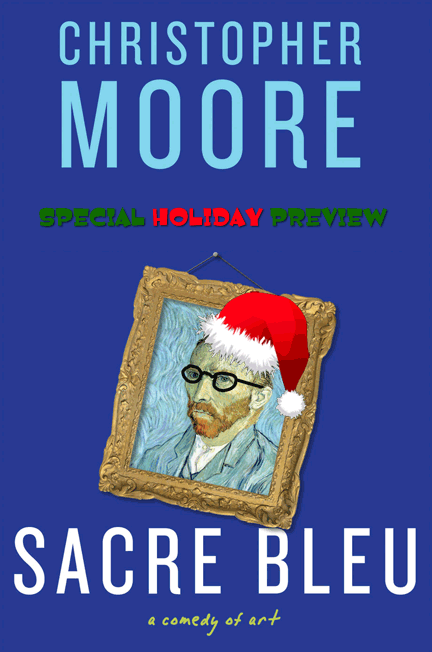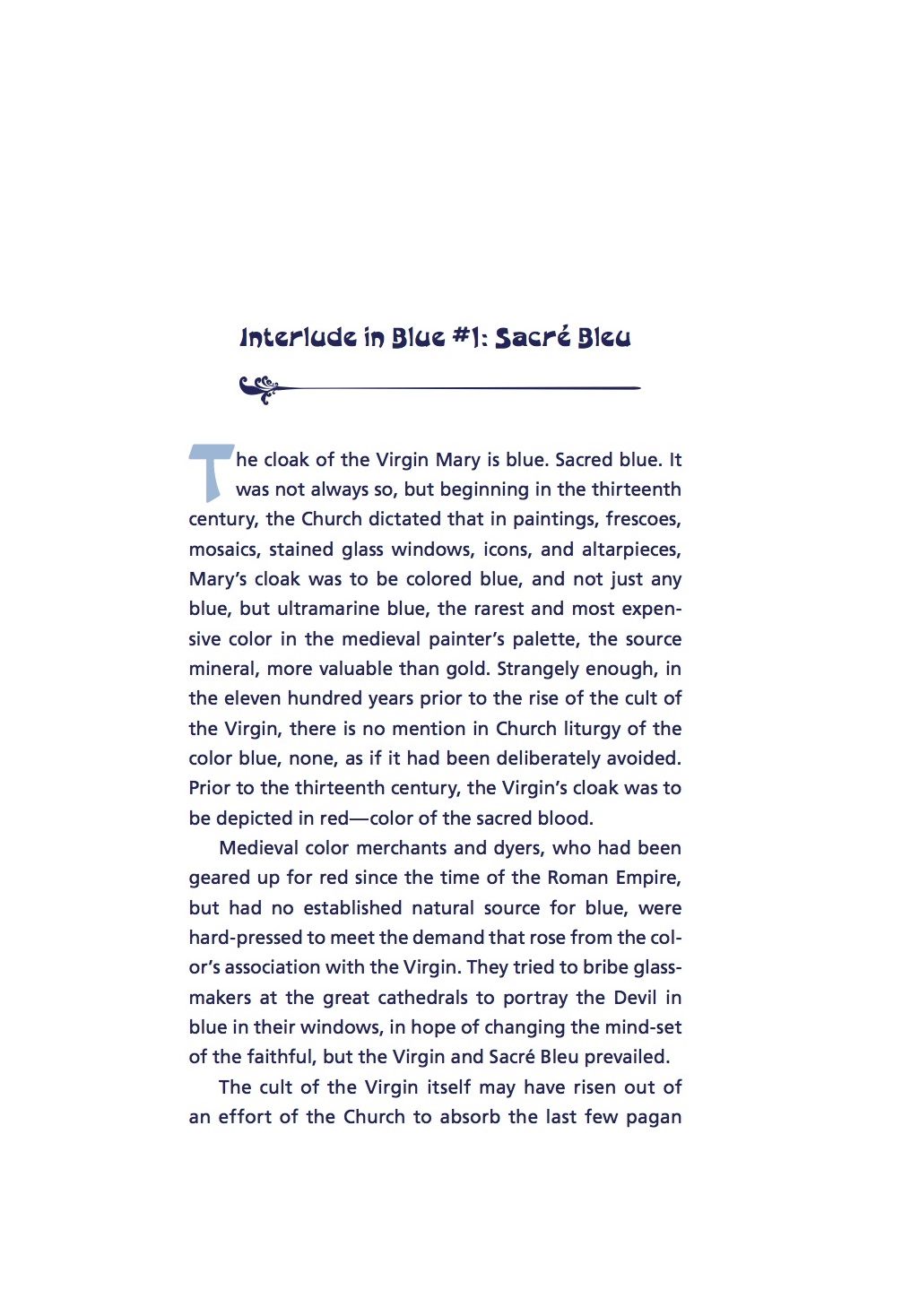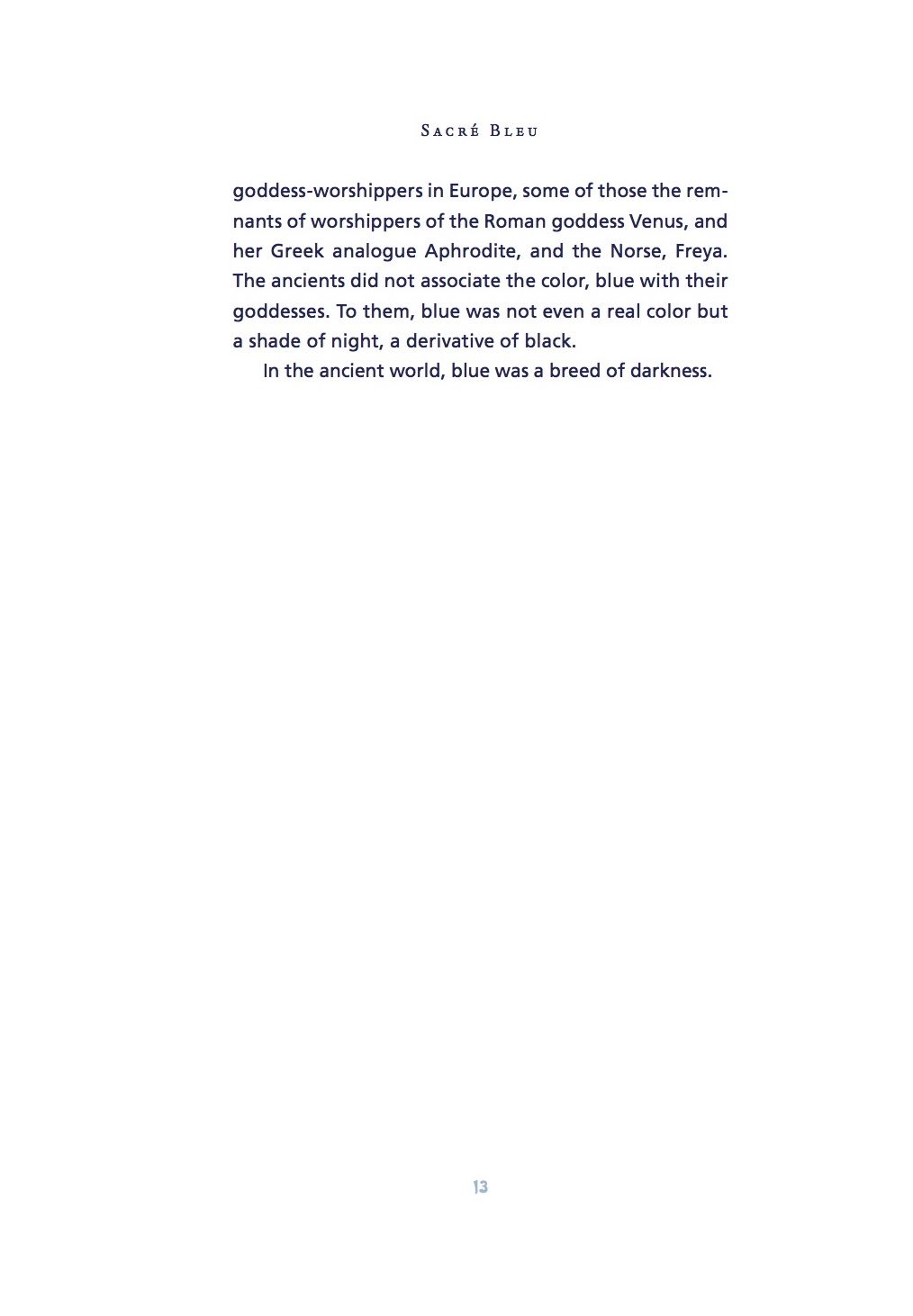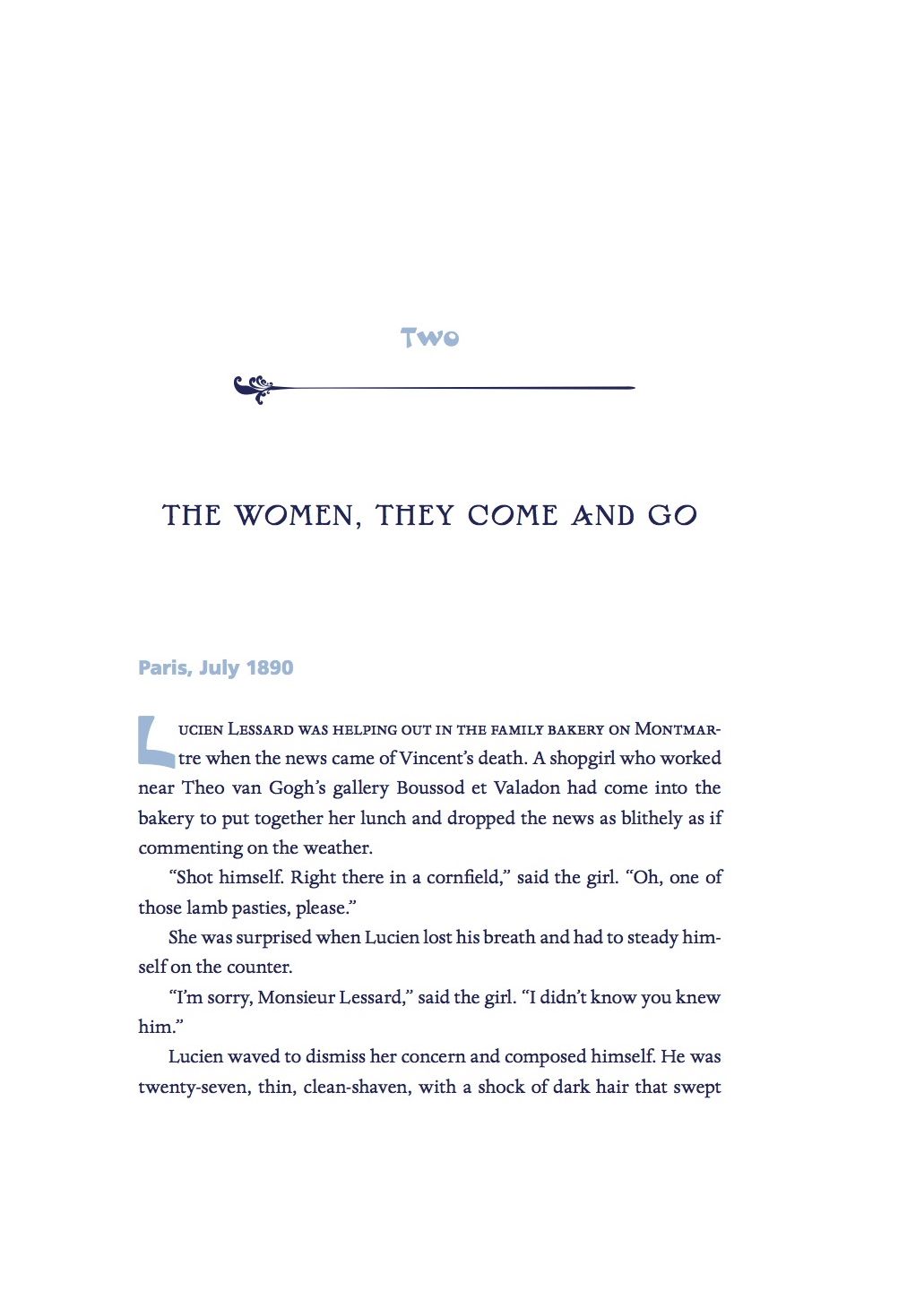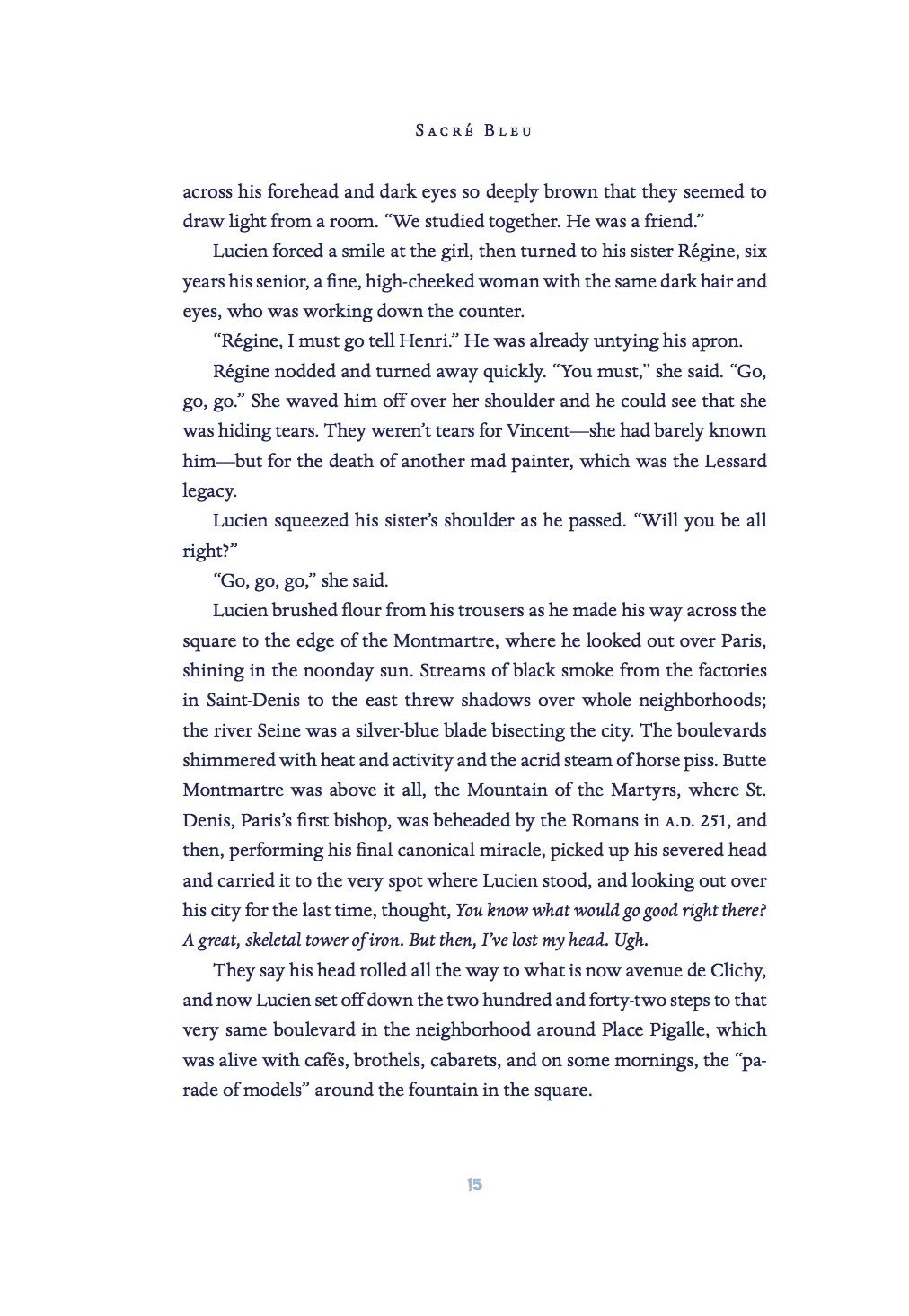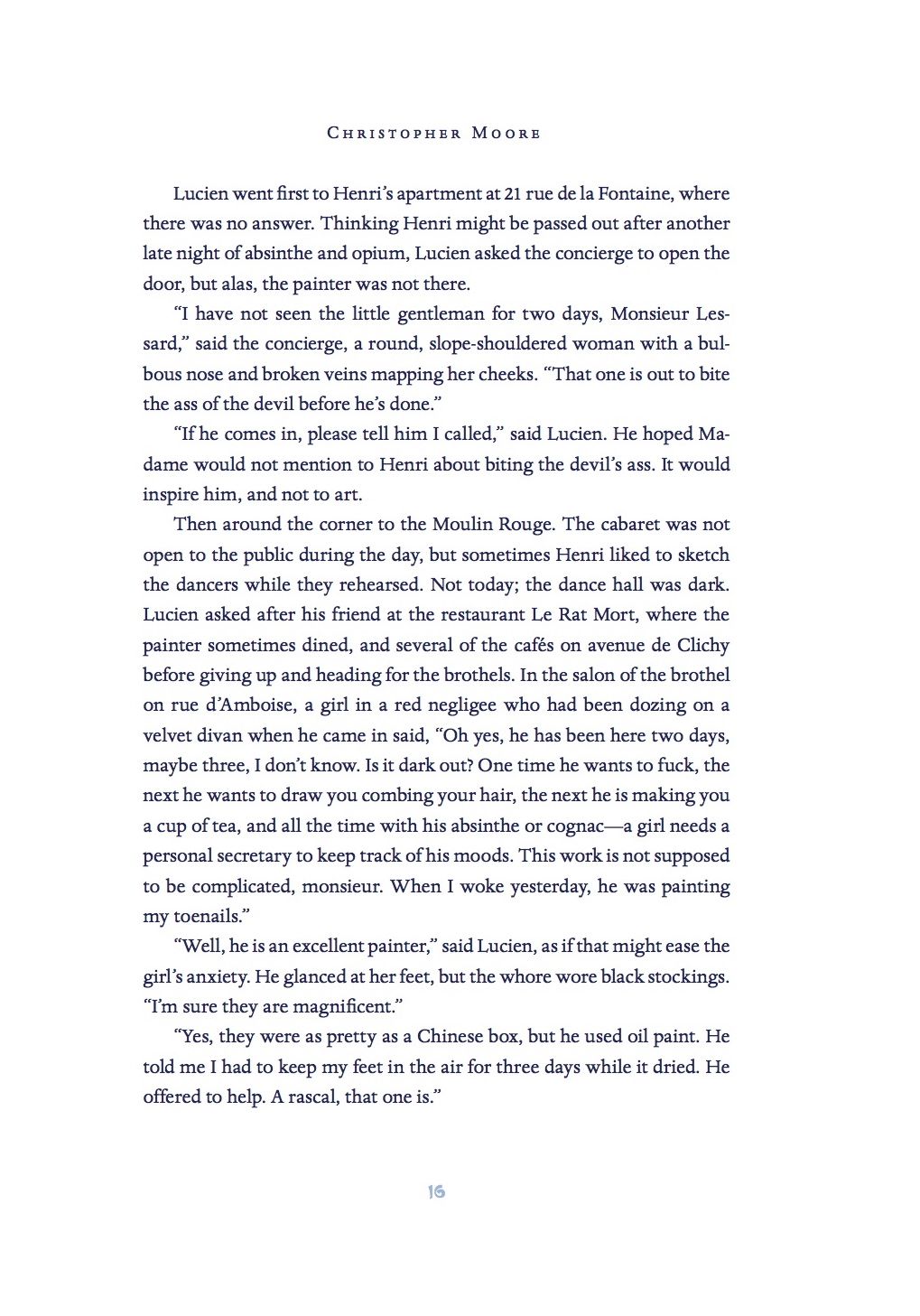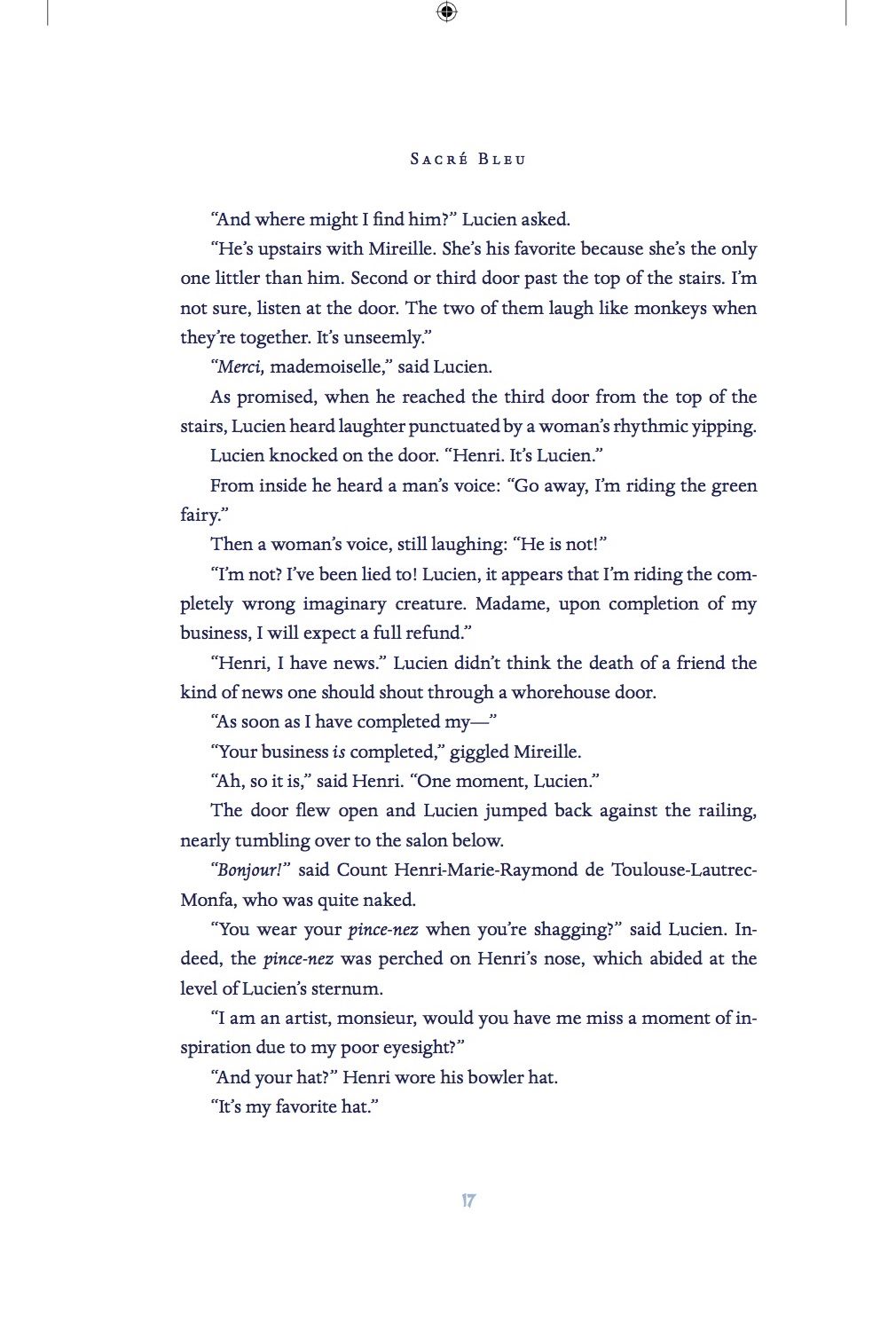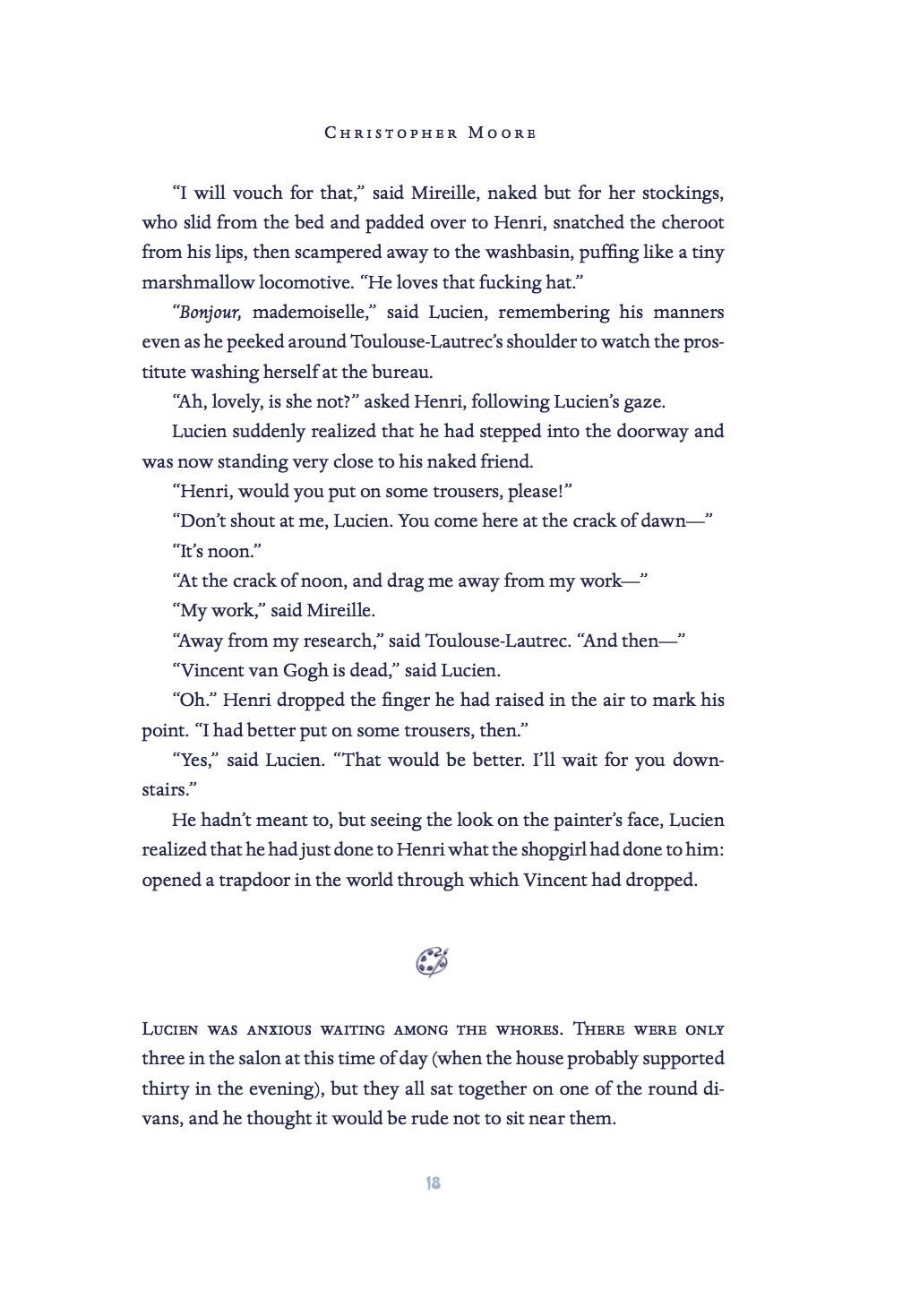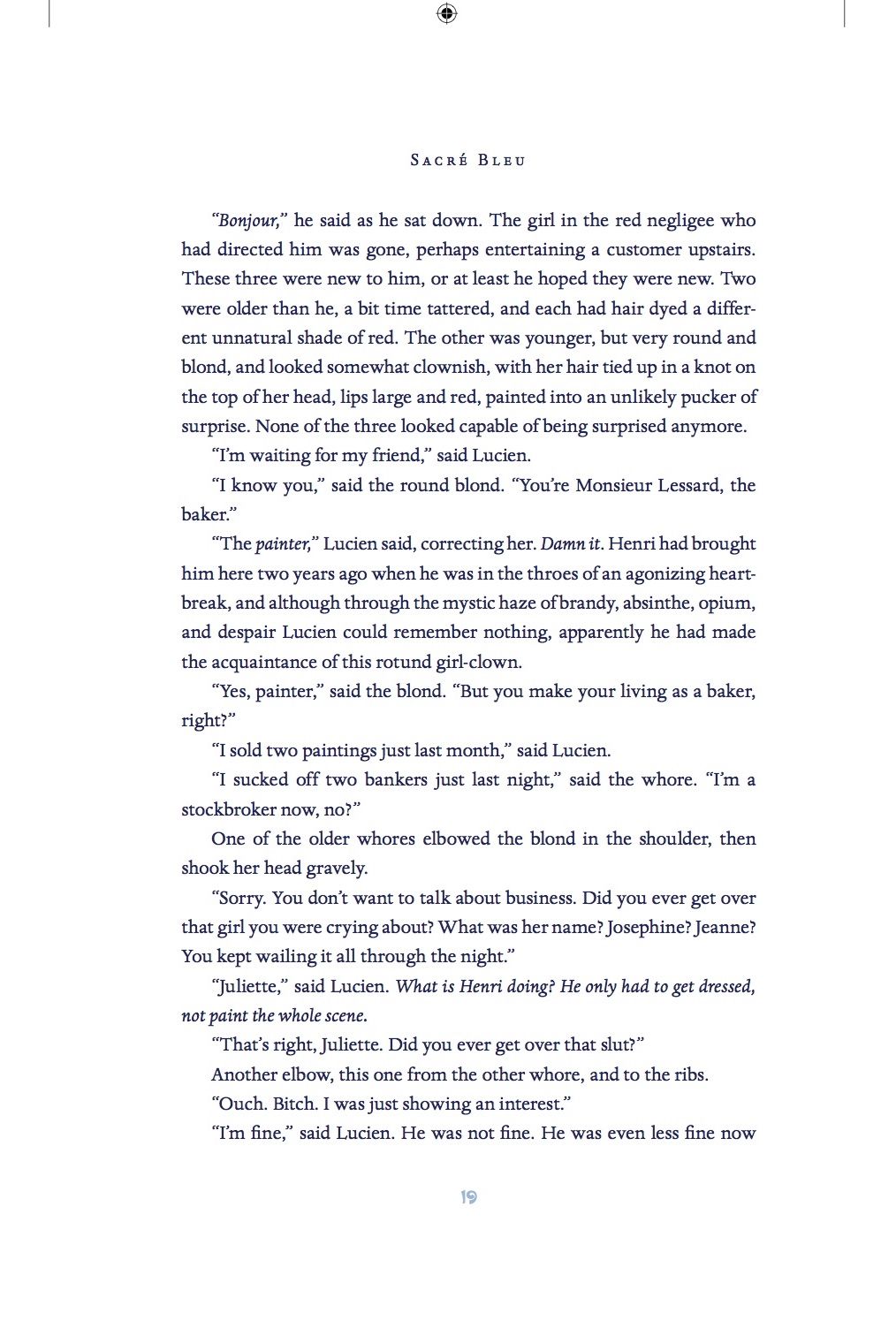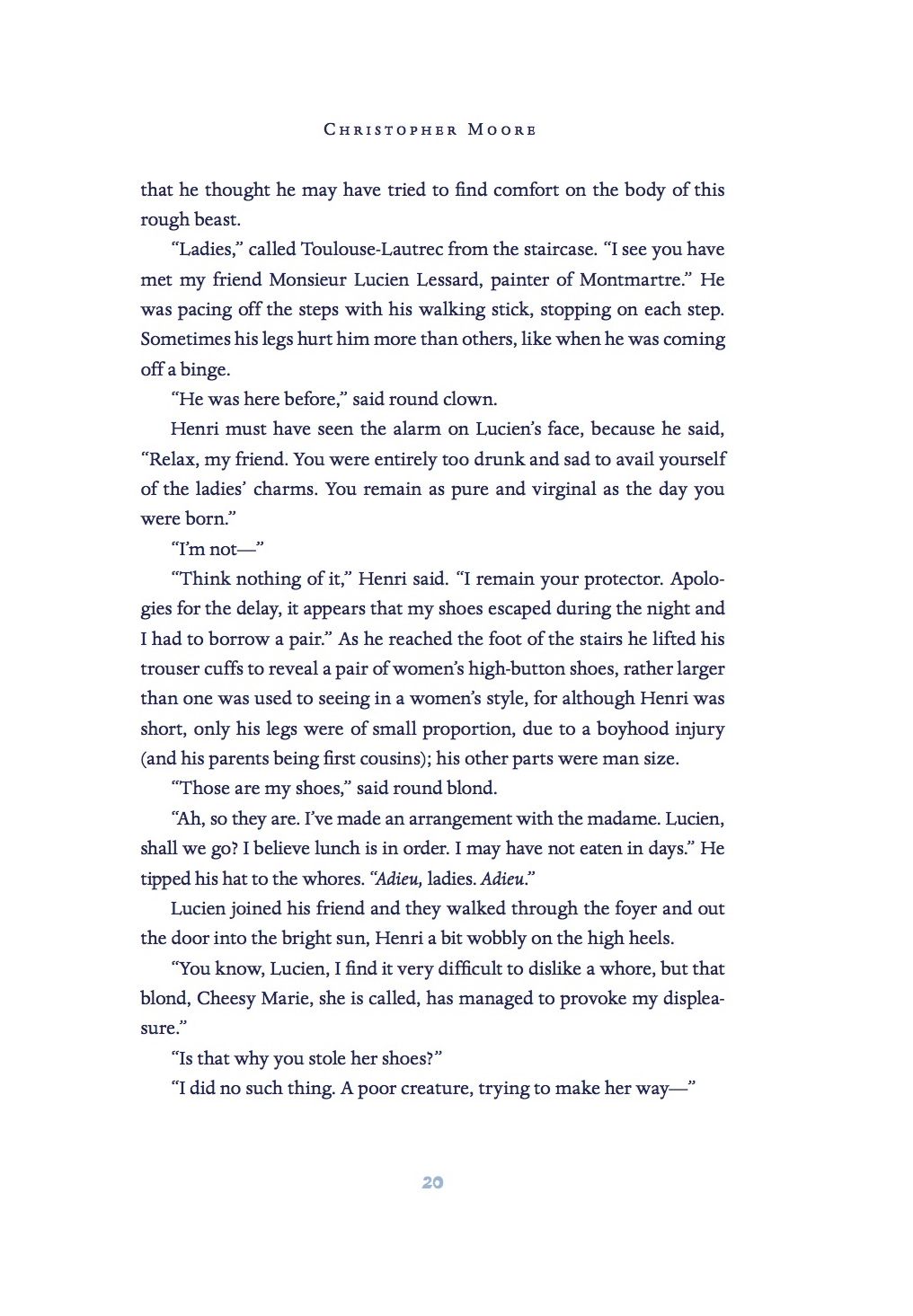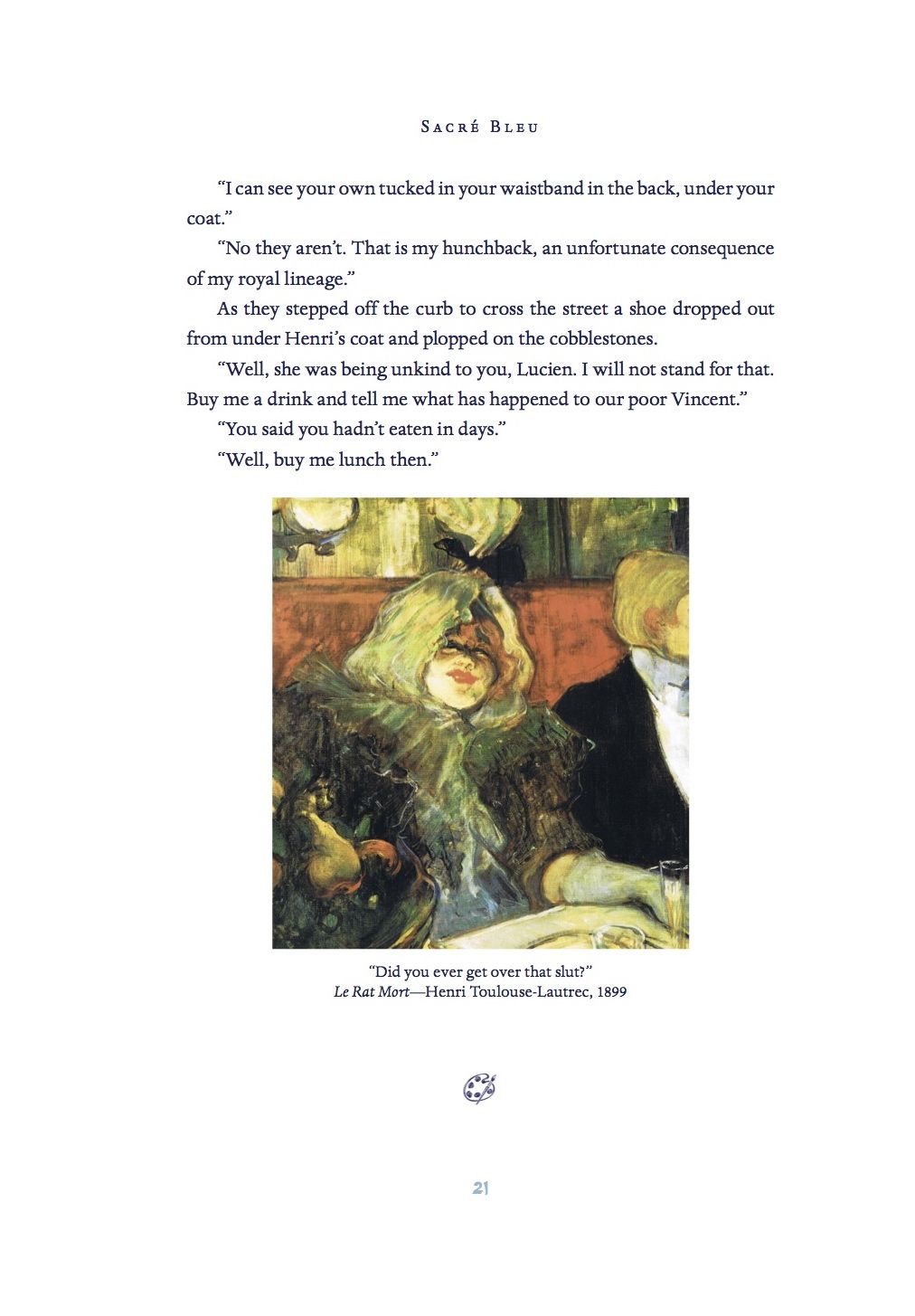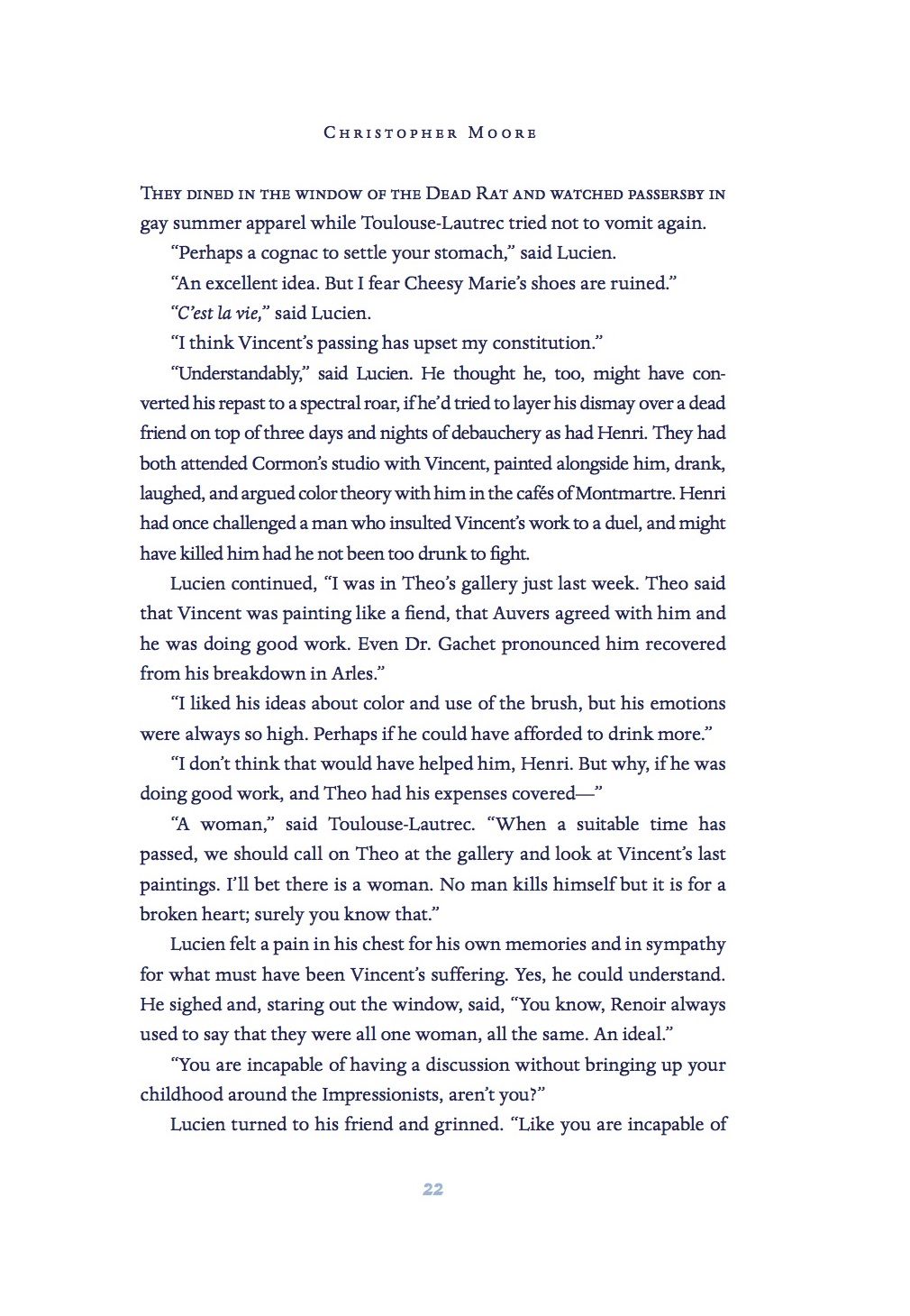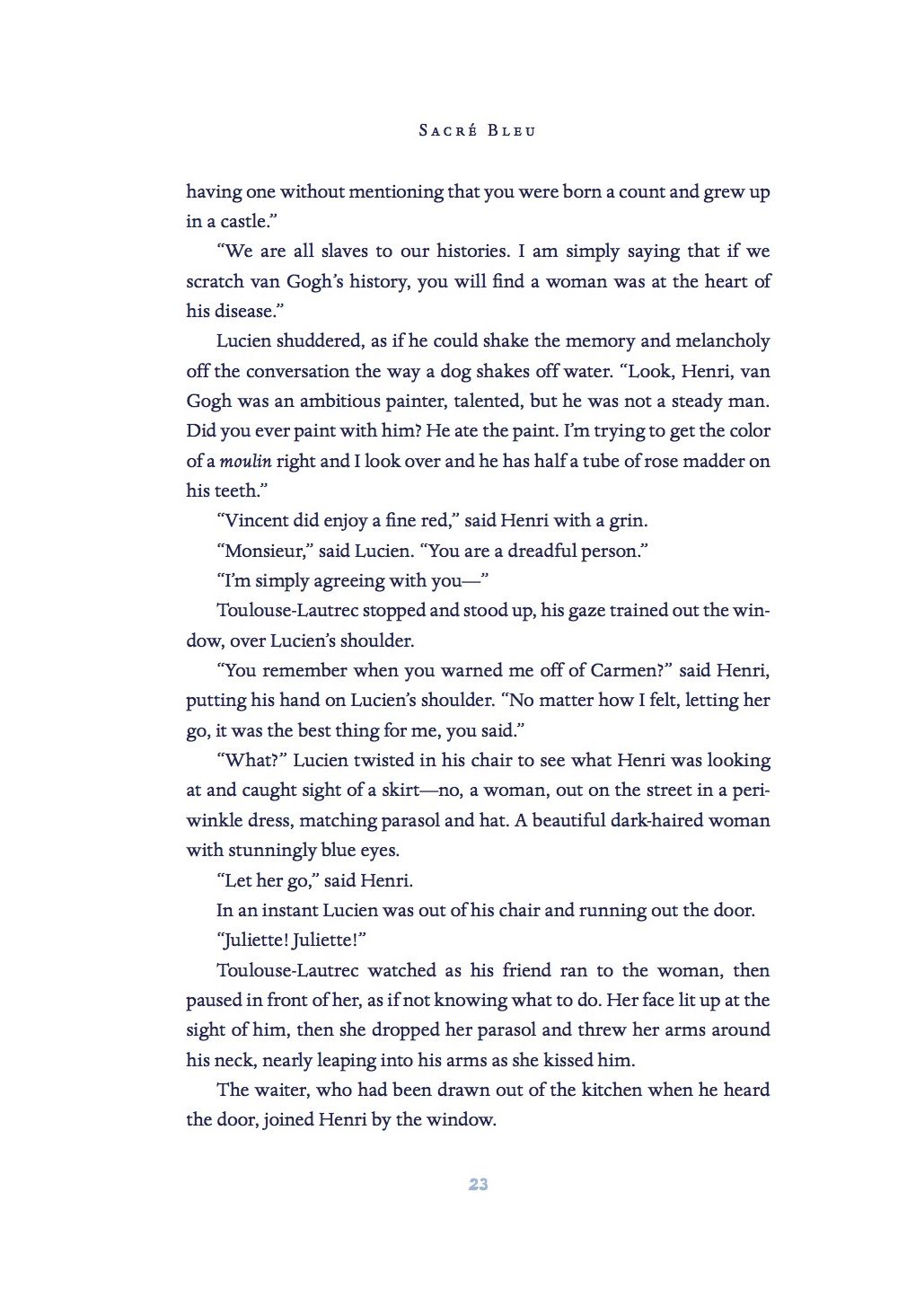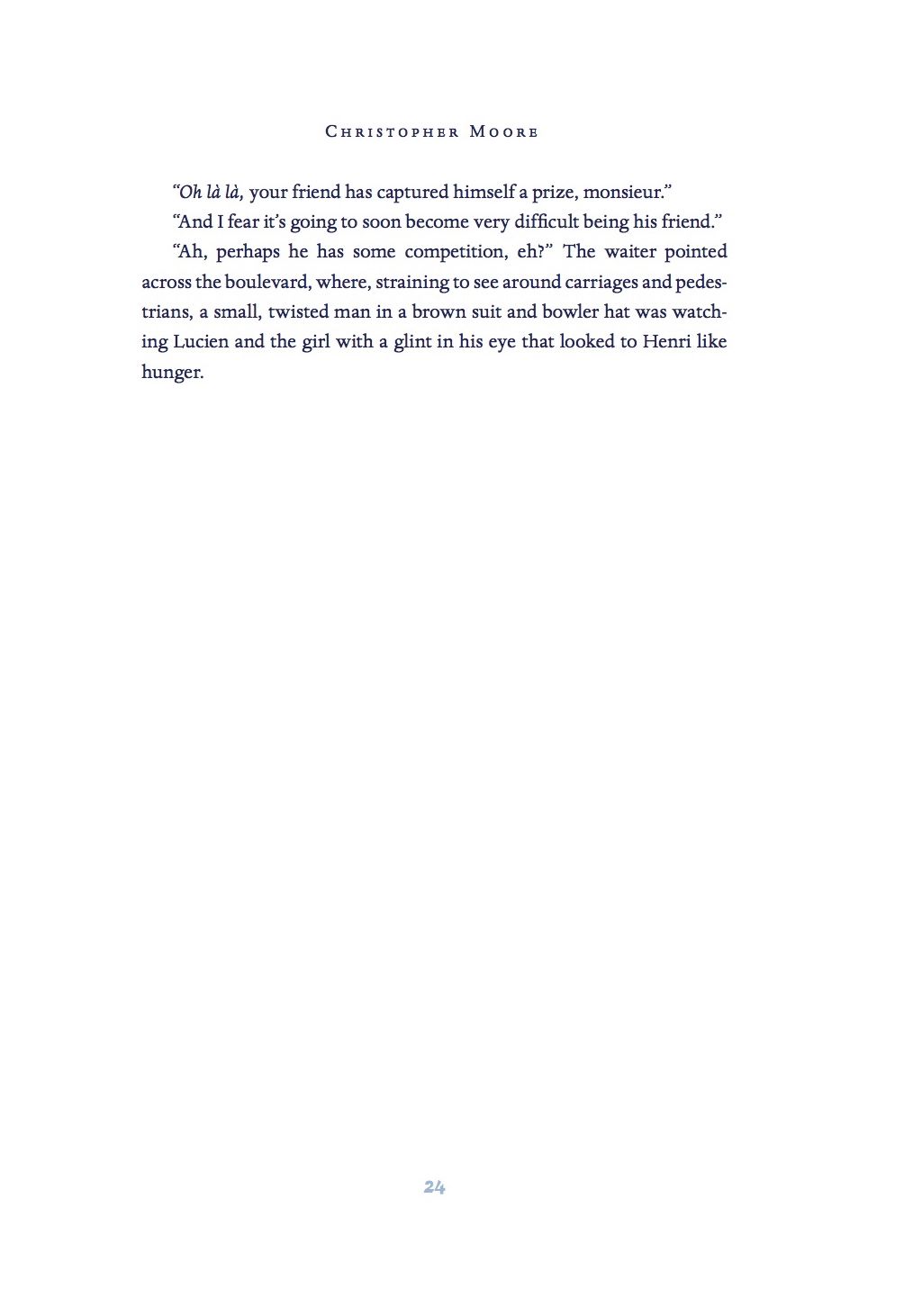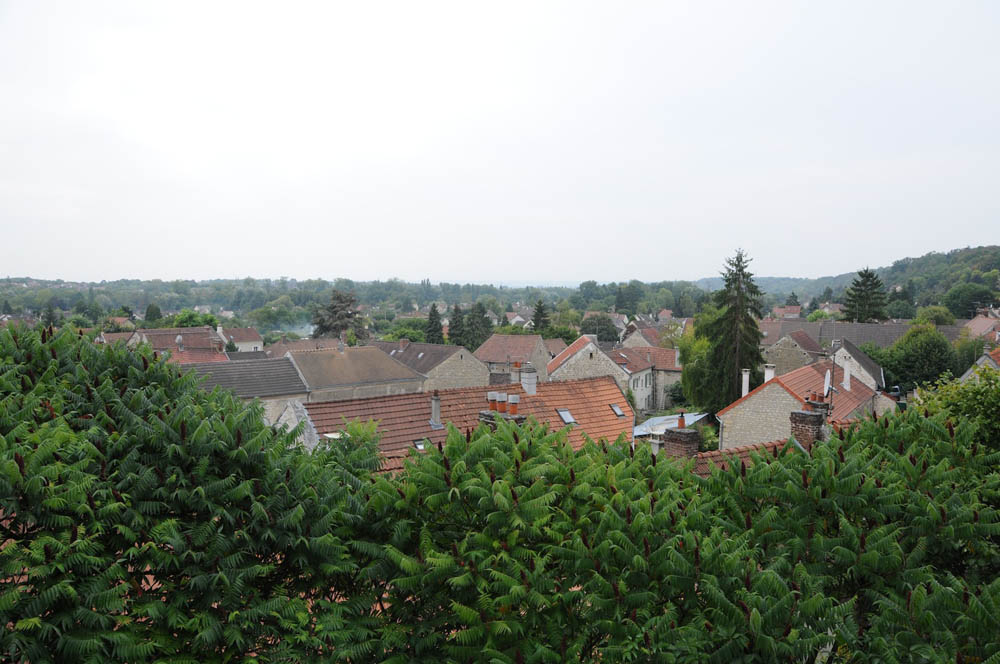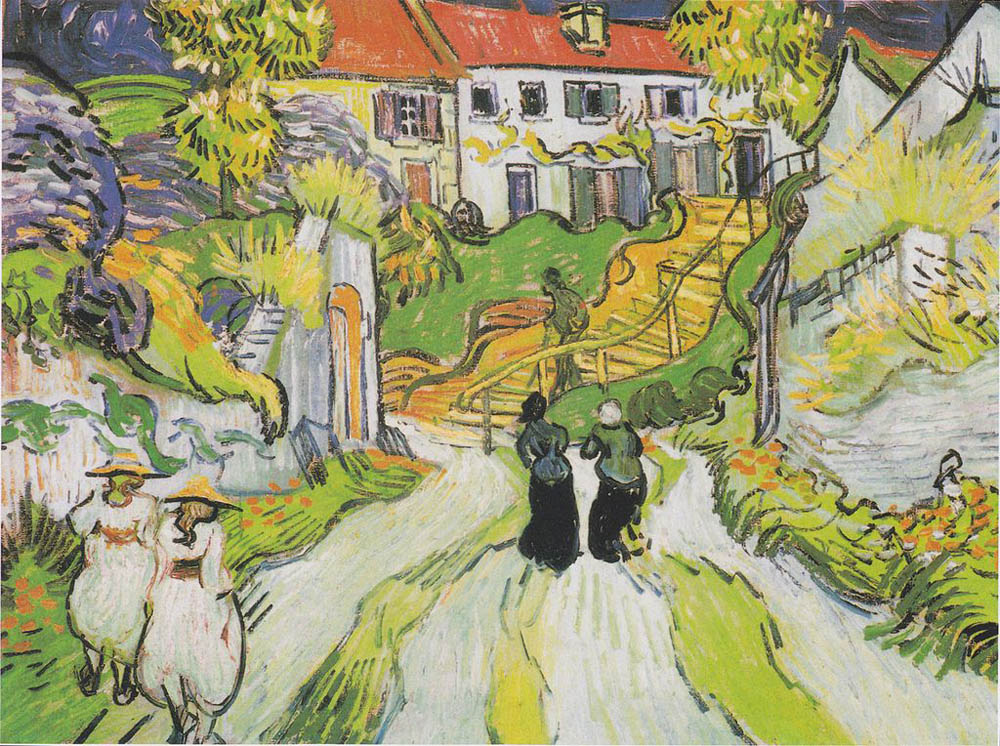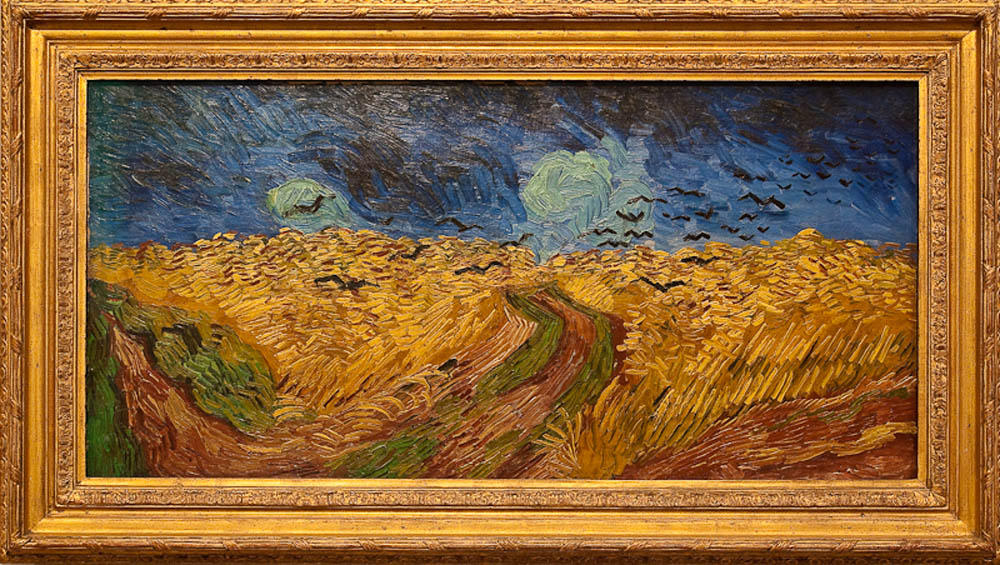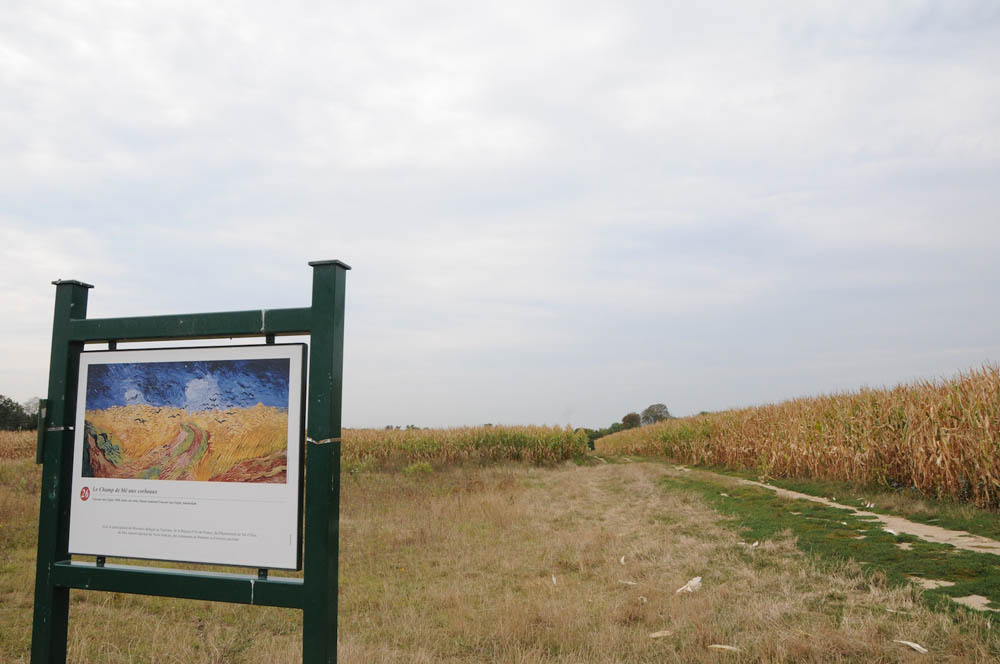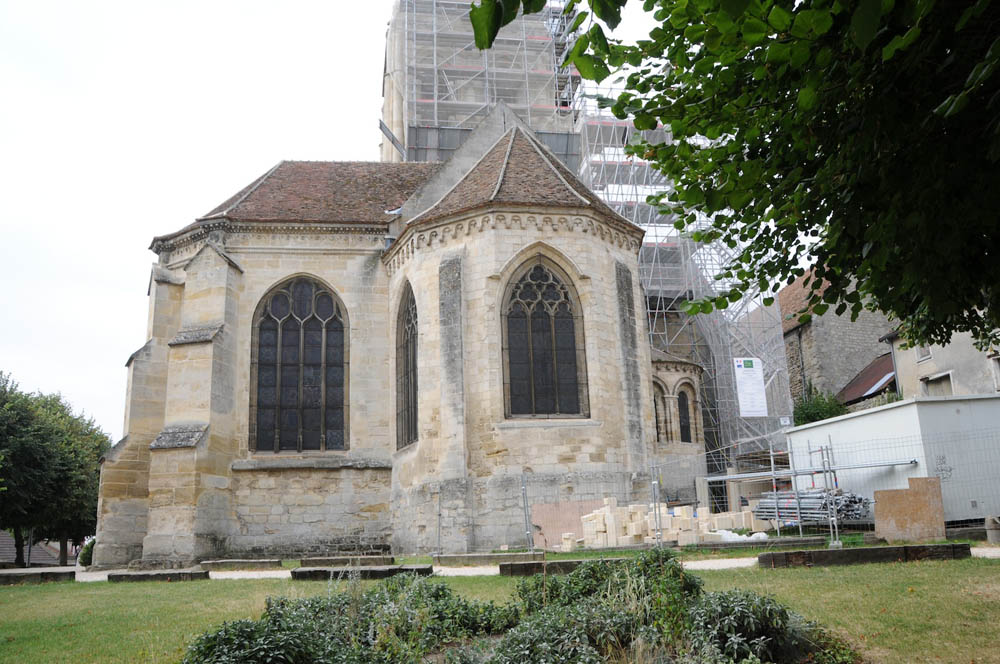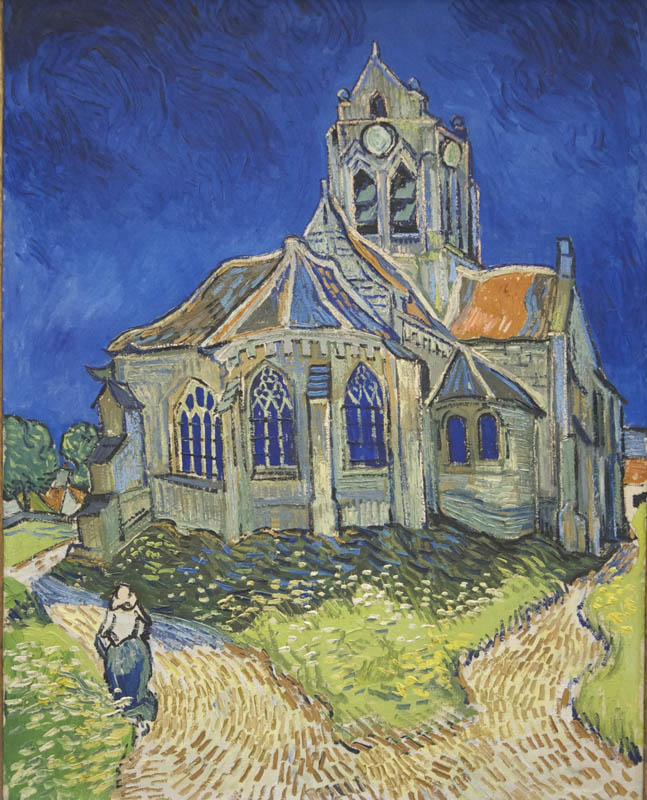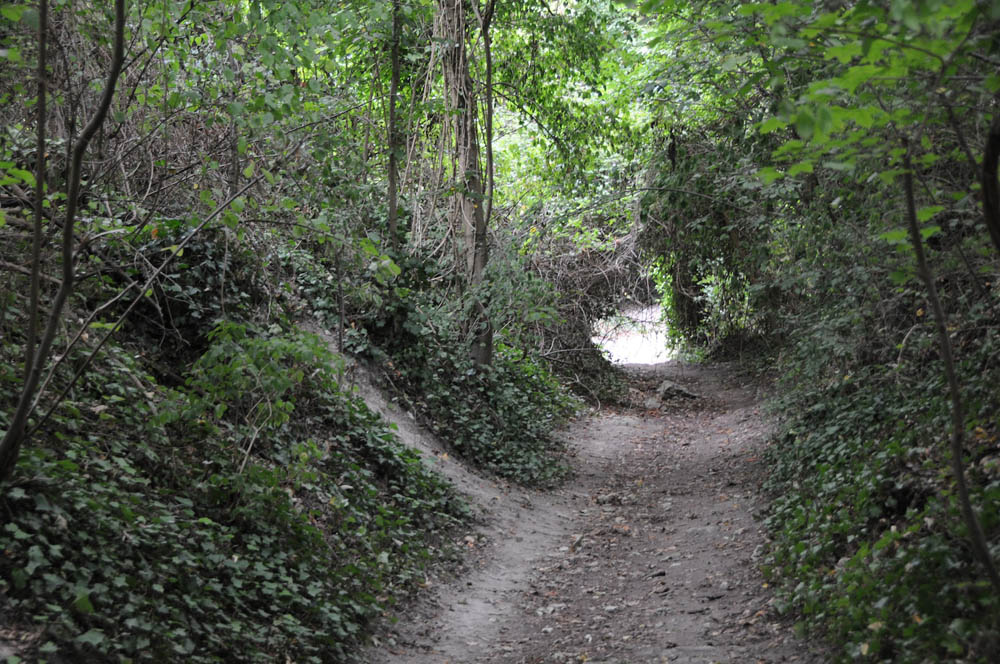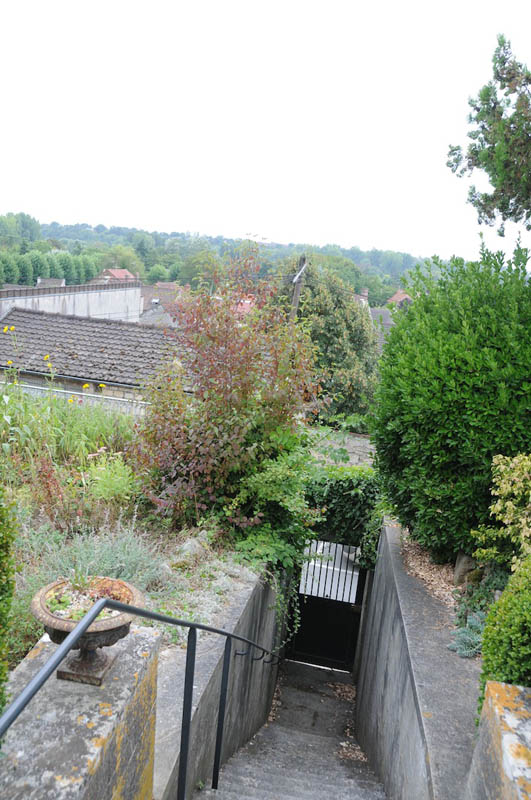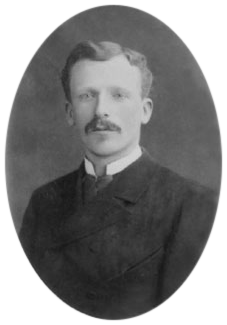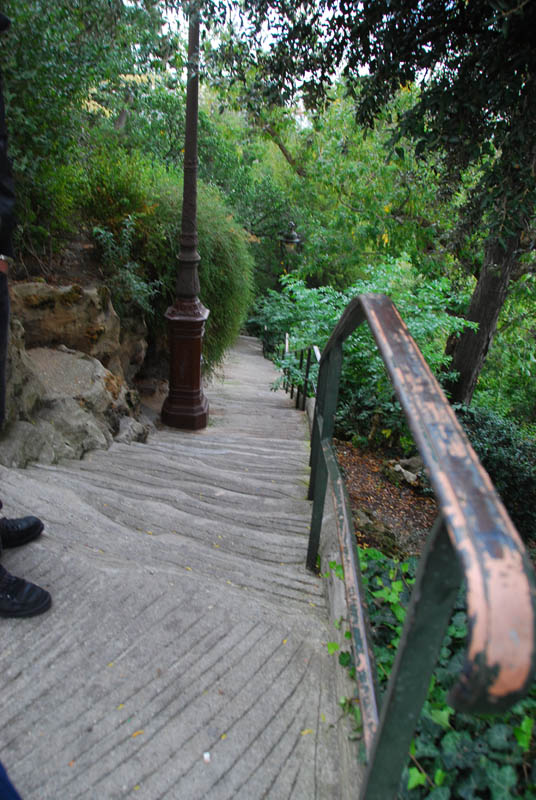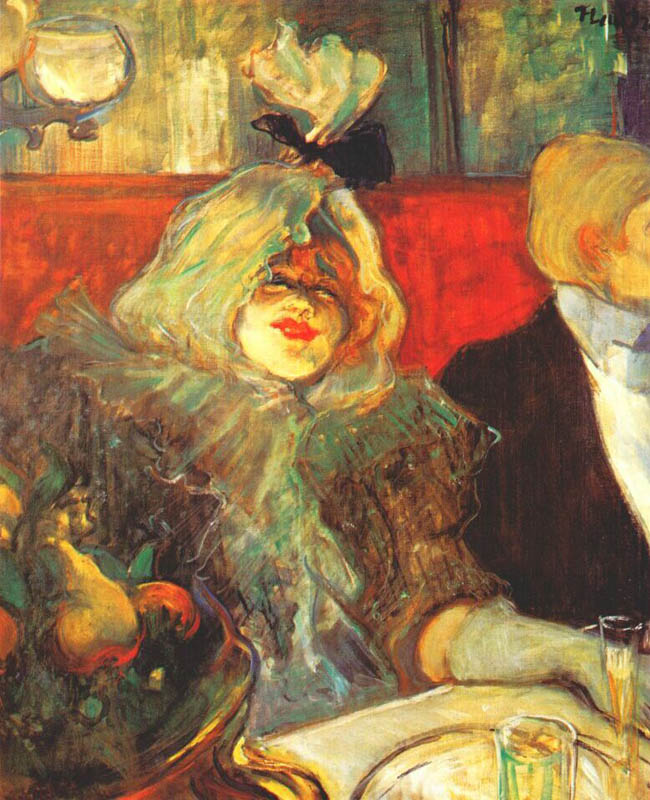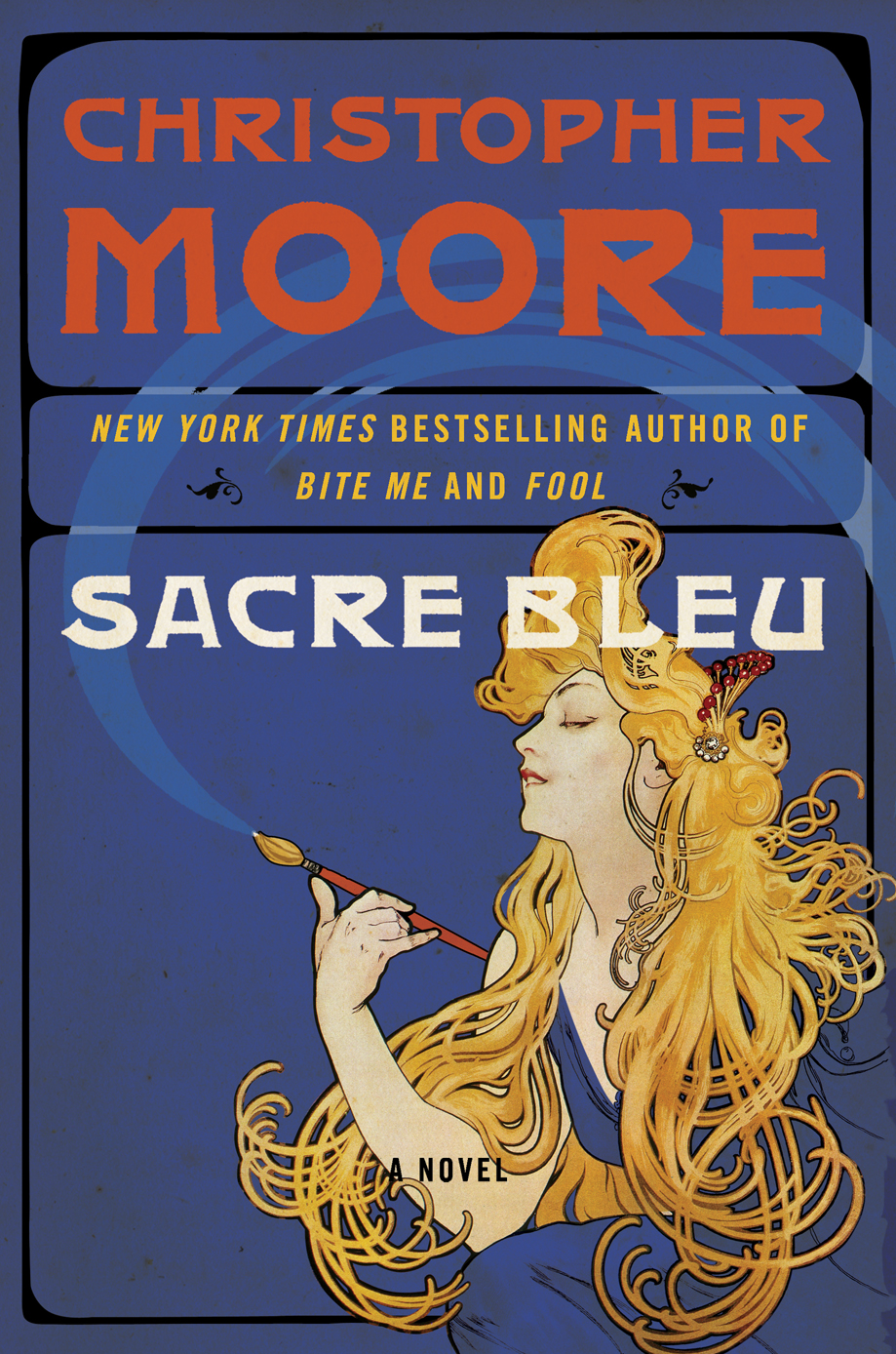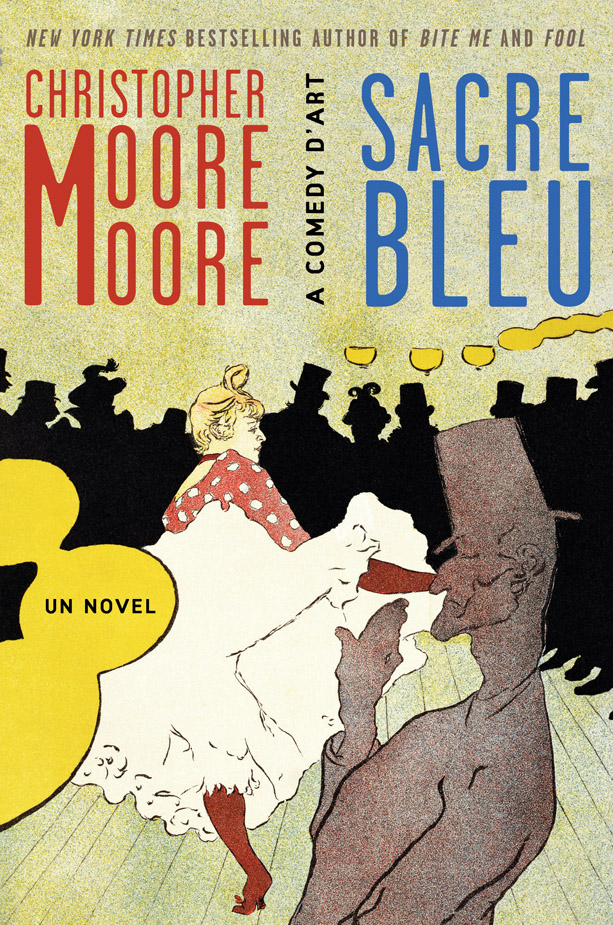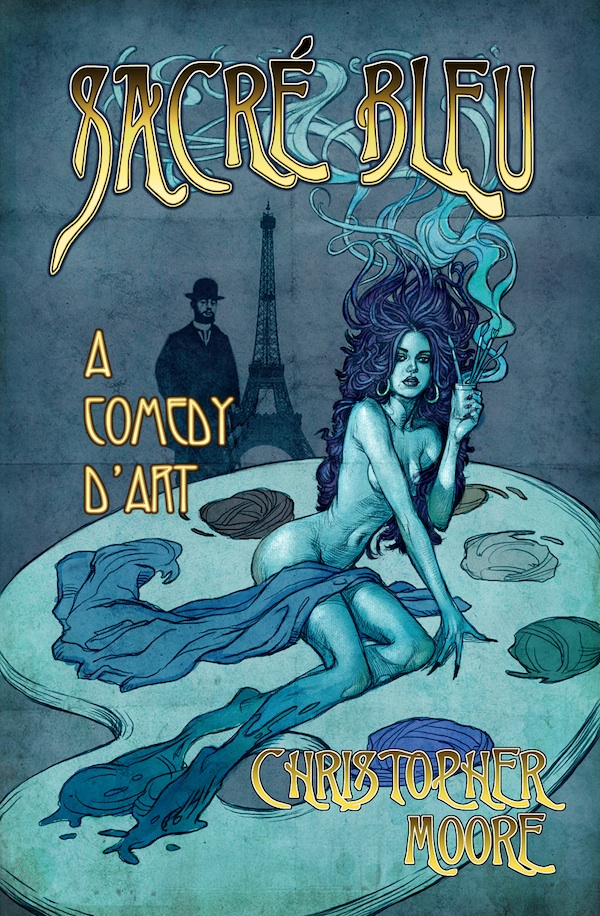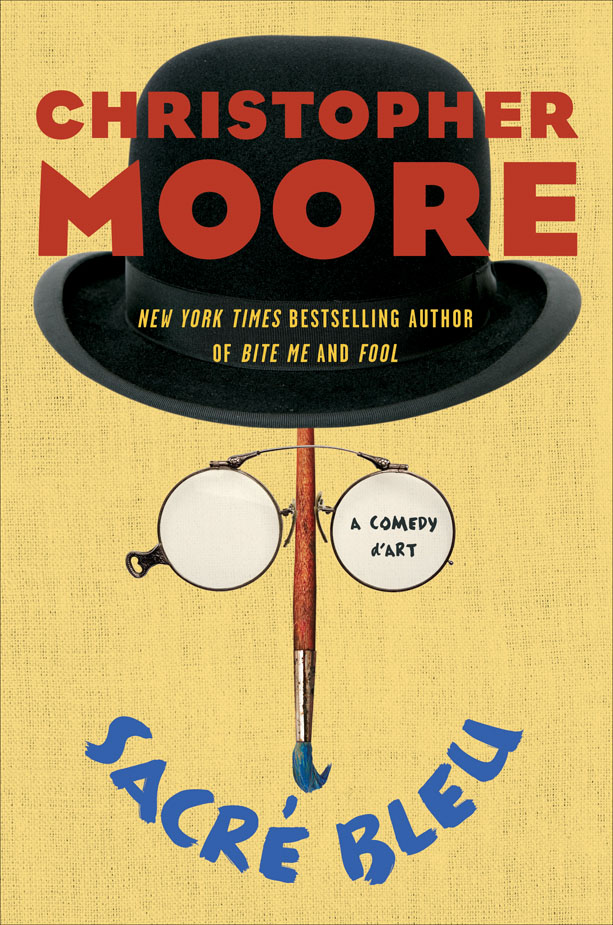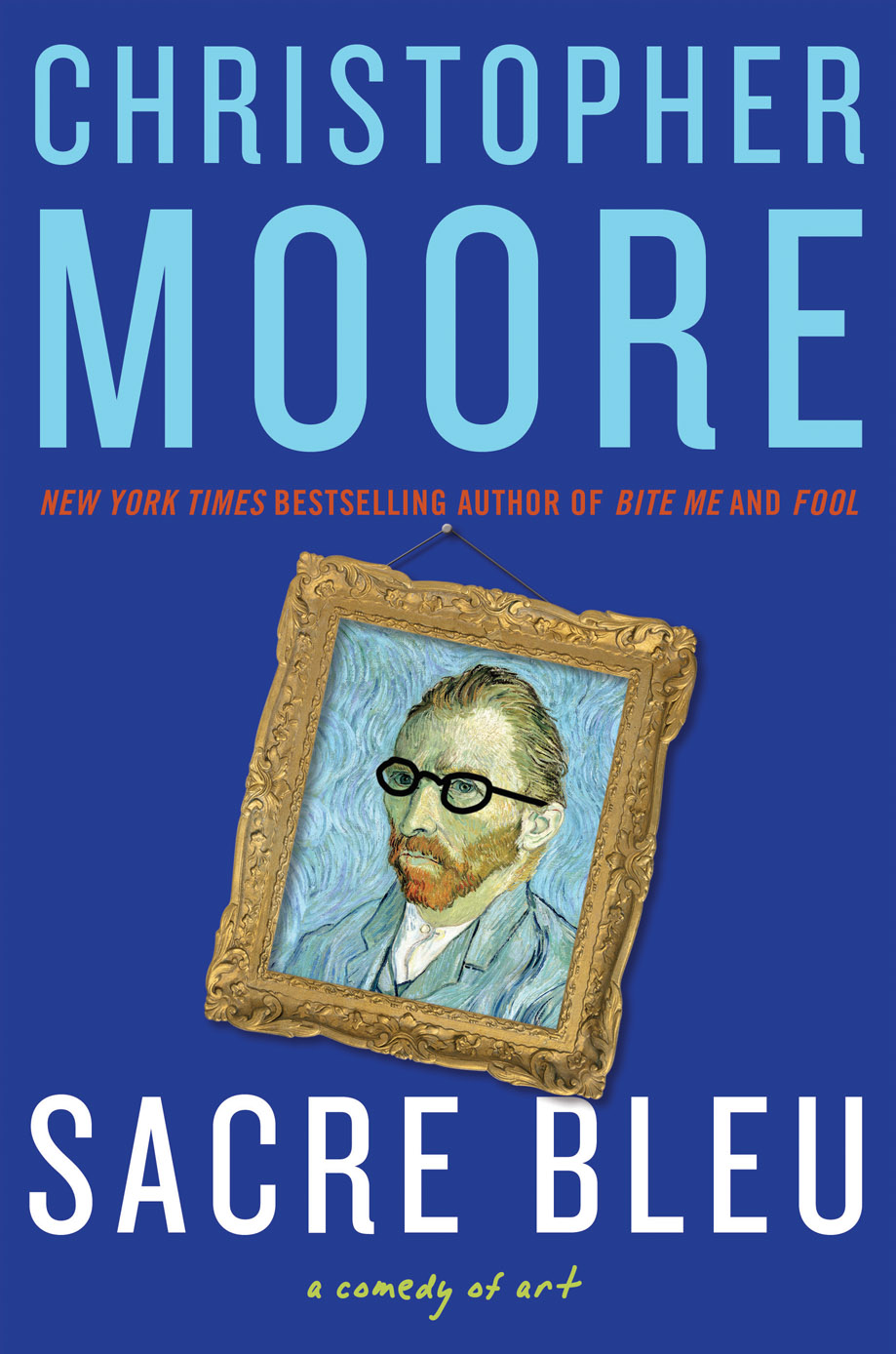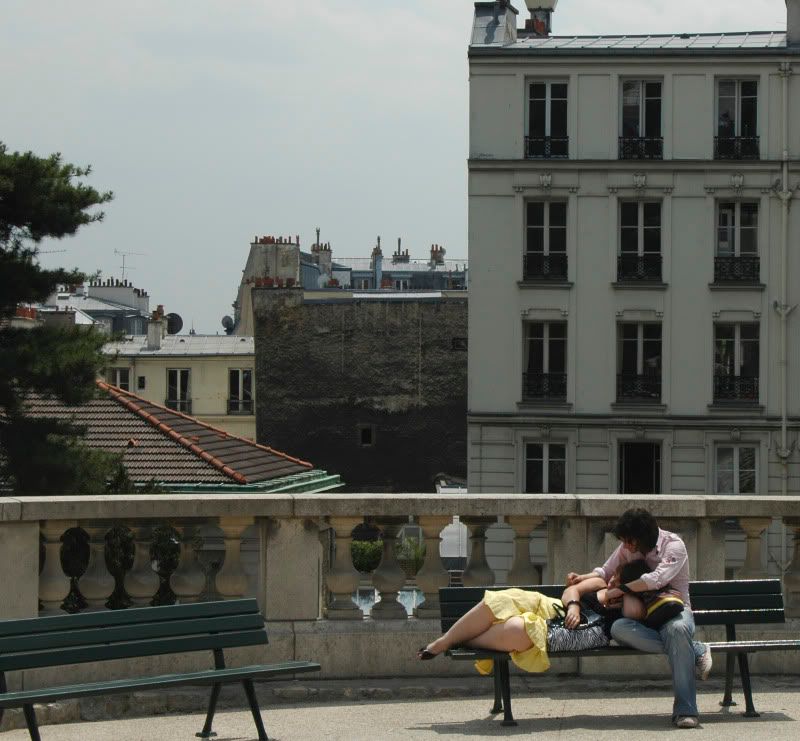It’s Christopher Moore, author guy, here you’ll find all kinds of goofy stuff relating to art, comedy, the French, and stuff that obliquely relates to my book Sacré Bleu (April 2012). Check back for new stuff, this will be changing as I learn new stuff.
A Long Audio Interview About Sacré Bleu
Here’s in in-depth audio interview I did about Sacré Bleu with Rick Kleffle of NPR and the Agony Podcast. I’d recommend you’ve read the book before listening to this, as there are some spoilers, but none that give the actual plot away, only a few incidents and settings that are based in history. It’s about an hour.
http://bookotron.com/agony/news/2012/04-30-12-podcast.htm#podcast043012
It’s also available on Itunes if you want to download it for your IOS device for later. Just put ‘The Agony Column” in the search window. I’ll link it directly here once I figure out how to do that.
ASK THE AUTHORGUY brings you, BOOK SIGNING FAQs
Since I announced my 2012 book tour, a lot of people have been asking, “What goes on at a book-signing?” The following answers apply only to MY events, book-signings by other authors are different. For instance, while there is no real “appropriate” attire for one of my events, if you’re at a Chuck Palahniuk event, you’ll want to wear your best bondage-wear (leather or PVC), and carry plastic sheeting. Chuck’s events are very much like a Gallagher comedy act, except in place of watermelons, human body parts are splattered on the audience, which is why Chuck is America’s most beloved author. That said, while you may have to stand in line unattended at one of my signings, at Neil Gaiman events there are “line monitors,” burly security guys who are there to catch Goth girls (and boys) who faint over Neil’s dreaminess. At a Lemony Snicket event, you might be entertained by Toccata and Fugue played on an accordion and encouraged to murder your parents (or at least frame them for embezzlement, ) while at one of my events, the closest you’ll come to being entertained is watching me swig Nyquil while spooging hand-sand on myself and others in a series of anti-viral “money-shots”.
So, to your questions:
1)What is the most important thing to consider in coming to one of your events?
1)ans: Parking. This is doubly important if you are driving.
2)Do I have to buy a book to attend?
2)ans: Most stores, now, require you buy at least one book per group, or a ticket, which usually includes a book. This varies from store to store and you should call the store and ask before betting your whole afternoon or evening on it. I’ve listed all of their contact information on Google.
3)Can I get your other books signed, my older books?
3)Yes, but often I have to limit how many I can personalize, especially if there’s a big crowd. The store may require that you buy the new one there, but most are okay if you bring your old books, and I’ll sign all that you bring. It helps if you have them turned to the “title page”, which is the first page on which my name appears. Collectors and dealers who have a bunch of books are asked to wait until the end and — access to the author for dealers is up to the discretion of the event store. (If you’re a dealer or a collector, you probably know this.)
4)I don’t know what to say. It’s my big moment, I’ve been waiting in line, and I don’t know what to say…
4) Most authors have been on your side of the table and know what that is like. I remember being terrified to speak to Ray Bradbury, and later Harlan Ellison. Hell, even now I get nervous when I meet authors. We get it. We also have all done events where no one but the bookstore staff was there, so we’re grateful you’re there. No author doesn’t like to hear that you love his or her books, that you share them with friends. It doesn’t get old, and it’s exactly the thing to say. I appreciate it. On the other hand, don’t pitch your idea for a screenplay or novel. I am powerless to help you and there are people waiting.
5)You like pie. Can I bring you pie? Or, you know, a meerkat?
5)Presents are very sweet, but an author on tour usually has one carry-on bag and his or her version of a computer bag – for the whole month, which means things are packed to the max. We just don’t have room to take along gifts, nor the time to send them on or even eat snacks. (I’ve even run out of room to carry my receipts and had to ship them home mid-way through the tour.) I’ve left a multitude of thoughtful gifts in hotel rooms because I couldn’t get them into my bag. That goes double for books and regional delicacies like bar-b-que sauce or maple syrup. (We’re getting on a plane in the morning, remember?) We just don’t have room for them. I have had many dinners consisting entirely of goldfish crackers brought to me by readers, and I really thank you for that, but it’s probably not the best policy. CDs and Manuscripts are out of the question. First, I can’t read manuscripts even if I want to, agents orders, and I don’t travel with a CD player, not even in my computer, so the discs often have to be left behind a stop or two down the road, anyway.
6)What can we expect? Do you read your work? Give back-rubs? What’s up?
6) The main thing to remember is, LOWER YOUR EXPECTATIONS. I’m a writer, if I was a people person they wouldn’t lock me in a room by myself to do my job. I don’t read my stuff. I suck at it. That said, there’s some variation in how events proceed– especially this tour, since some events are in theaters, but usually a bunch of you sit down, someone introduces me, I talk about writing books and stuff for about 20-40 minutes, take some questions, and then I sign books. Each book store has a different way of managing the line. Some have tickets, or bookmarks, or wrist-bands, other’s go by the “dog-pile” approach. At some events, I will have signed all of the books in advance so you’ll get a signed book even if you don’t have time to stand in line. We started doing this a couple of books ago when I’d get letters from people who had come but had to leave because of a baby-sitter or something before they got to meet me and get their book signed. You can still stand in line and I’ll personalize your book, but usually in these cases, the line is shorter because those people who just wanted to hear me talk or get a signed book can bolt.
7)What sort of questions should we ask?
7)Not “Where do you get your ideas?” (Now that I’ve told you that, I know that the first question will always be, “Where do you get your ideas?” because, let’s face it, my work appeals to the smart-ass demographic, but I’m going to just tell you “From Jules Verne”, or “from Bazooka Joe Comics” or something equally absurd, so whatever…) The one thing I ask is that as the tour proceeds, and you’ve had time to read the book, is you not ask something that’s a “spoiler” for those who haven’t had a chance to read it yet. Oh, no movies are being made of my books. If that changes, I’ll let you know.
8)What else do we need to know?
8)Most anything else should be addressed to the specific book store, because they really dictate the policy for events. Call them. They’ll know about parking, places to eat near-by, stuff like that. My advice, on meals, by the way, is on an evening event, eat before you come to the book store. I do. Sometimes these things can run late.
9)Will you sign other stuff?
9)I will, but it’s limited. It takes quite a while to sign fabric items, I have to go slow, so be considerate of your line homeys when you ask. Fucksox are nearly impossible, so let’s not go there. Body parts are also really tough. (I can’t believe I’m actually typing this.) I know you’d love to have a tattoo on your uvula of my signature, but as much as I cherish the fun of poking you in the uvula with a Sharpie, may I suggest getting something else signed, like tracing paper or clear plastic, and taking that to your tattoo artist. That way, too, you can sober up and think it through.
10)What about pictures?
10) I’m fine with you taking pictures with me. Sometimes the store will have someone who will help – take your phone or camera so you can get in the picture—but sometimes, not, so you’ll want to have stuff ready. If the store doesn’t have someone, then make friends with the person in line behind you to take the shot – show them how to use your phone, get it all set up. The we’ll all dogpile into the photo and it will be tons of fun.
Signed First Editions of Sacre Bleu
Signed First Editions of Sacre Bleu
Sorry, kids, as of 5/15/2012 both Mysterious Galaxy and Books Inc have suspended their shipment of signed firsts of Sacré Bleu. I’ll put up a new link if any become available.
Mysterioius Galaxy will be taking orders for signed first edtions, which will ship after April 10th, when I’m there. Remember, only the first printing of Sacré Bleu will have color art and print. After they it will be in black and white, so jump on these if you’re not near a tour city. If you order before the 8th, these will be the color, first printings.
Signed Sacre Bleu firsts as well as other titles. (Contact store if something you want isn’t listed.) Also, international readers should order from Mysterious Galaxy, below. Their shipping is significantly less expensive for international orders. Yes, including Canada.)
International and Canadian Buyers read this note from Mysterious Galaxy:
Keep in mind that shipping charges for foreign orders are set by the system and are often adjusted down to reflect actual charges. One copy of Chris’s book to Canada is $12.95 and to most of Europe and Australia is $16.95 in a priority envelop according to the USPS website. If the charge to your country is more than $16.95 US, we will contact you.
Signed Firsts from Mysterious Galaxy:
NOTE: Books Inc has suspended taking more orders until after the event, April 3rd, so they’ll be sure to have enough for the event in San Francisco (See Tour Post on this Blog)
Advanced Reviews for Sacré Bleu
KIRKUS REVIEWS
SACRE BLEU
Author: Moore, Christopher
Review Issue Date: February 15, 2012
Online Publish Date: February 5, 2012
Publisher:Morrow/HarperCollins
Pages: 416
Price ( Hardcover ): $26.99
Publication Date: April 3, 2012
ISBN ( Hardcover ): 978-0-06-177974-9
Category: Fiction
An aspiring painter and unabashed romantic joins the greatest artists of the age in chasing his muse across fin de siècle–era France.
There are really two ages and two operating modes for hugely popular comedic writer Moore (The Griff, 2011, etc.). There’s the deceptively easy humor of his early California novels, which only gets sharper and funnier in his San Francisco–based vampire novels. But from time to time, Moore gets obsessed with a particular subject, lending a richer layer to his peculiar brand of irreverent humor—see Lamb (2003), Fluke (2003) and Fool (2009) for examples. Here, the author gets art deeply under his fingernails for a wryly madcap and sometimes touching romp through the late 19th century. The story surrounds the mysterious suicide of Vincent van Gogh, who famously shot himself in a French wheat field only to walk a mile to a doctor’s house. The mystery, which is slowly but cleverly revealed through the course of the book, is blue: specifically the exclusive ultramarine pigment that accents pictures created by the likes of Michelangelo and van Gogh. To find the origin of the hue, Moore brings on Lucien Lessard, a baker, aspiring artist and lover of Juliette, the brunette beauty who breaks his heart. After van Gogh’s death, Lucien joins up with the diminutive force of nature Henri Toulouse-Lautrec to track down the inspiration behind the Sacré Bleu. In the shadows, lurking for centuries, is a perverse paint dealer dubbed The Colorman, who tempts the world’s great artists with his unique hues and a mysterious female companion who brings revelation—and often syphilis (it is Moore, after all). Into the palette, Moore throws a dizzying array of characters, all expertly portrayed, from the oft-drunk “little gentleman” to a host of artists including Édouard Manet, Paul Gauguin, Georges Seurat, Claude Monet, Camille Pissarro and Pierre-Auguste Renoir.
Moore’s humor is, as ever, sweetly juvenile, but his arty comedy also captures the courage and rebellion of the Impressionists with an exultant joie de vivre.
Booklist
Sacre Bleu.
Moore, Christopher (Author)
Apr 2012. 416 p. Morrow, hardcover, $26.99. (9780062097749).
Moore drops his readers into the strange world of nineteenth-century France, where the line between past and present, real and surreal, shifts with a mere brushstroke. A baker and aspiring artist, protagonist Lucien Lessard grew up surrounded by Impressionist painters, all of whom seem to have fallen under the magical spell of a particular shade of blue. Van Gogh’s death and posthumous warning of a dangerous villain, the Colorman, sets Lessard and his friend, Henri Toulouse-Lautrec, off on a journey to discover the power behind the Colorman’s blue paint. Entwined in their journey is the beautiful but mysterious Juliette. Mingling comedy and mystery, Moore crafts an intricate story that teases the reader with numerous twists and bawdy humor. While Lessard is fictional, many of the characters are based on historical figures, and their use of modern slang can be jarring. Toulouse-Lautrec emerges vibrantly, but some of the other painters struggle to come to life. Still, this is an imaginative and amusing look at the Impressionist era, and Moore’s prose is fresh and engaging.
— Eve Gaus
LIBRARY JOURNAL
Moore, Christopher.
Sacré Bleu: A Comedy d’Art.
Morrow. Apr. 2012. c.416p. illus. ISBN 9780061779749. $26.99. F
Moore (Fool; You Suck) set out to write a book about the color blue. What he ended up with is a surprisingly complex novel full of love, death, art, and mystery. When baker–turned–aspiring artist Lucien Lessard, whose father was friends with some of the preeminent French artists of the late 19th century, receives a special tube of vibrant blue paint from the mysterious Juliette, his amateurish painting becomes masterly and his life becomes a mess. Obsessed with painting and loving Juliette, Lucien must discover the mystery of the blue paint, the origins of Juliette, and the identity of her near-constant companion, the frighteningly sinister Colorman who haunted other artists like Van Gogh, Monet, Pissarro, and Cézanne. In the end, the true question for Lucien is, “At what price art?” VERDICT Don’t let Moore’s quirky characters and bawdy language fool you. His writing has depth, and his peculiar take on the impressionists will reel you in. One part art history (with images of masterpieces interspersed with the narrative), one part paranormal mystery, and one part love story, this is a worthy read. Considering the large marketing push and Moore’s rabid fan base, expect demand.
Publishers Weekly February 6, 2012
Sacré Bleu
Christopher Moore. Morrow, $26.99 (416p) ISBN 978-0-06-177974-9
Art history is playfully—and perilously—rewritten in this ambitious novel by bestseller Moore (Bite Me). Working backward from the death of Vincent Van Gogh in 1890, we meet frustrated painter and favored son of a Paris bakery family, Lucien Lessard, whose best pal happens to be Henri Toulouse-Lautrec, that fabled frequenter of brothels. All his life, Lucien has heard words of wisdom and tutelage not only from Toulouse-Lautrec, but also Renoir, Pissarro, and Theo Van Gogh. But after Toulouse-Lautrec receives a strange letter from Van Gogh, dated just before his death, the two begin to investigate “the Colorman,” an odd figure who sold the titular brilliant ultramarine paint to all of these fabled painters during their most prolific, mad, and forgotten periods of work (the Colorman’s arrivals also coincided with the painters’ most intense love affairs). During their investigation, Lucien and Toulouse-Lautrec will discover that the mystery and Lucien’s muse, Juliette, are intimately connected. Spanning nearly 30 years—with a brief interlude in Roman times—the story is steeped in Western art: Renaissance Italy; medieval cathedrals; the fields and studios of pre, post, and high impressionism. Though the question at the story’s heart is less interesting than the fictional anecdotes about the great masters, fans of Moore’s mix of wit and slapstick will be pleased. Photos. Agent: Nicholas Ellison, the Nicholas Ellison Agency. (Apr. 3)
Sacré Bleu – The Holiday Preview
Hey Kids, here’s the first few chapters and sections of Sacre Bleu, which will come out April 3. Be sure to check out the Chapter Blog, which will cover the whole book when it’s released.Happy Holidays! Have a great year, and thanks for the enthusiasm and support. – Chris
This is not the final cover, but it is the design that readers picked as their favorite. 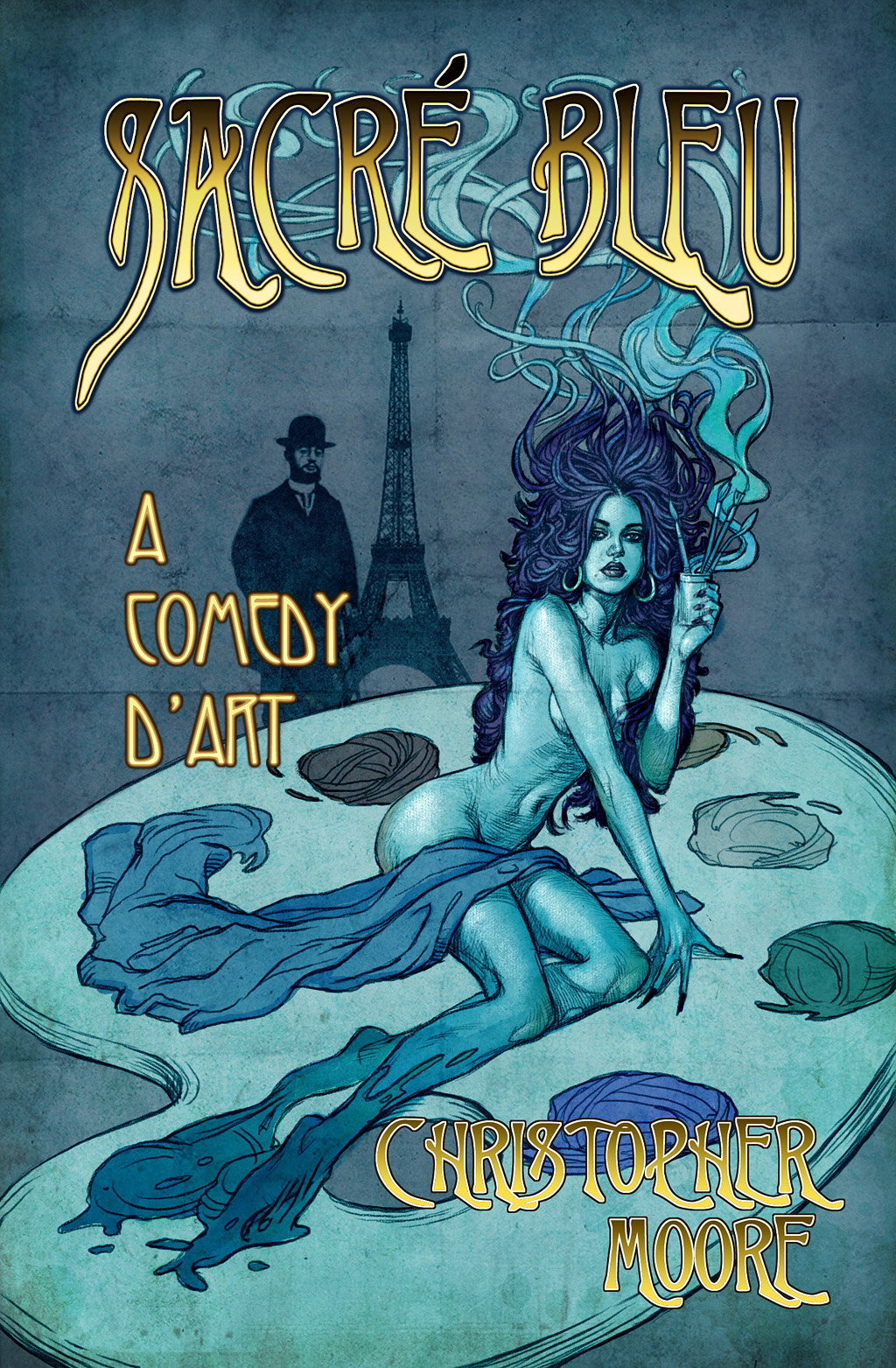
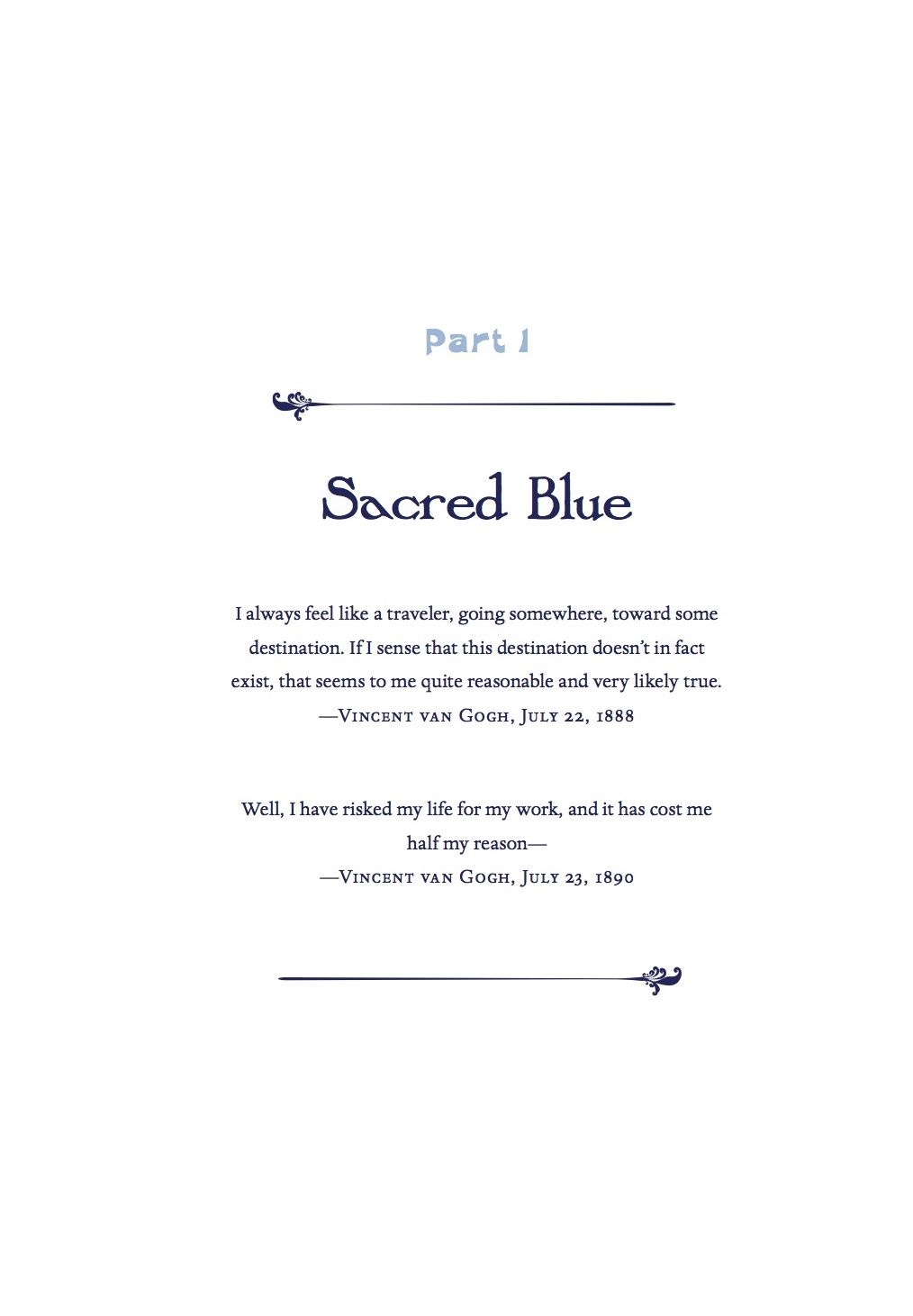
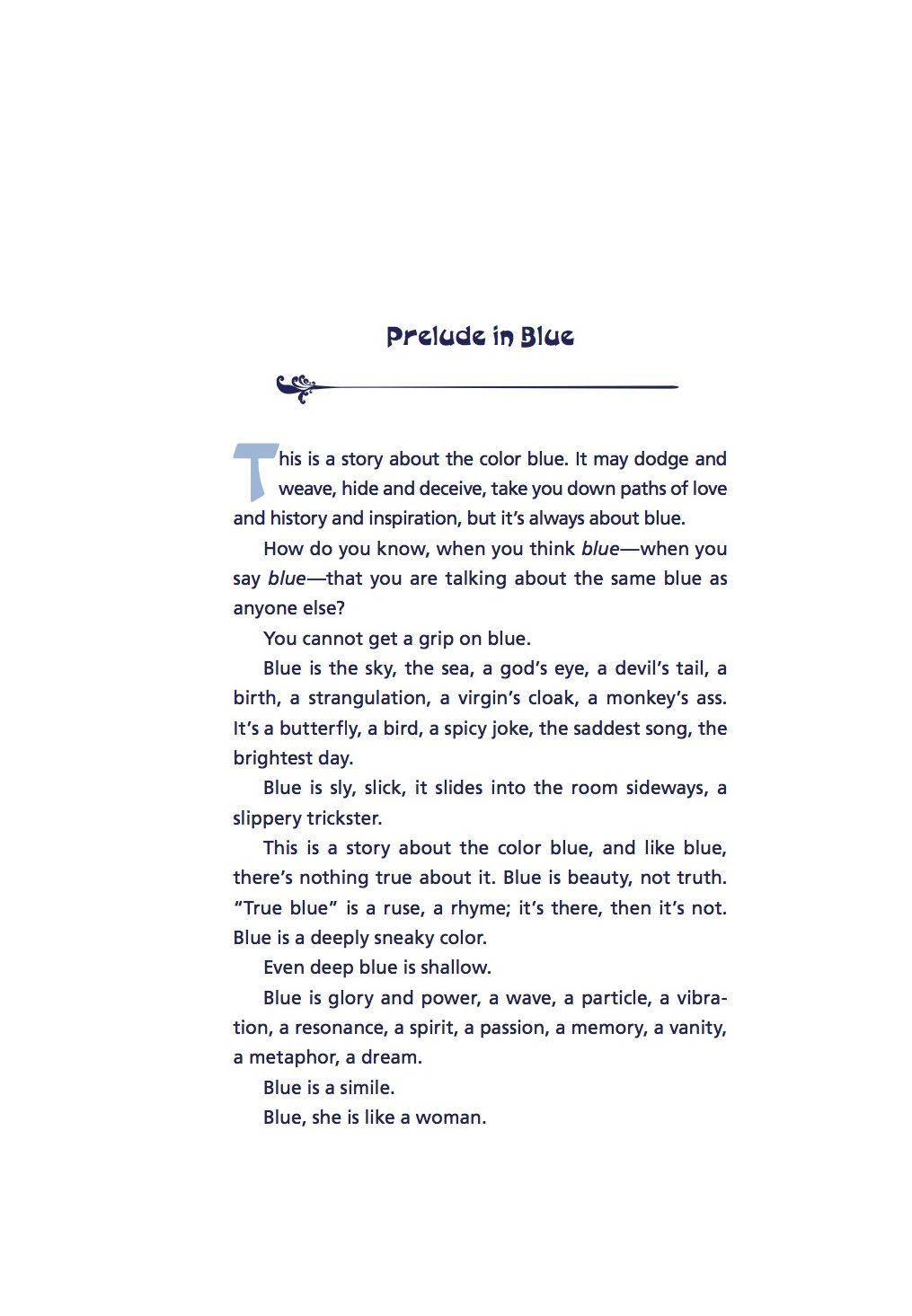
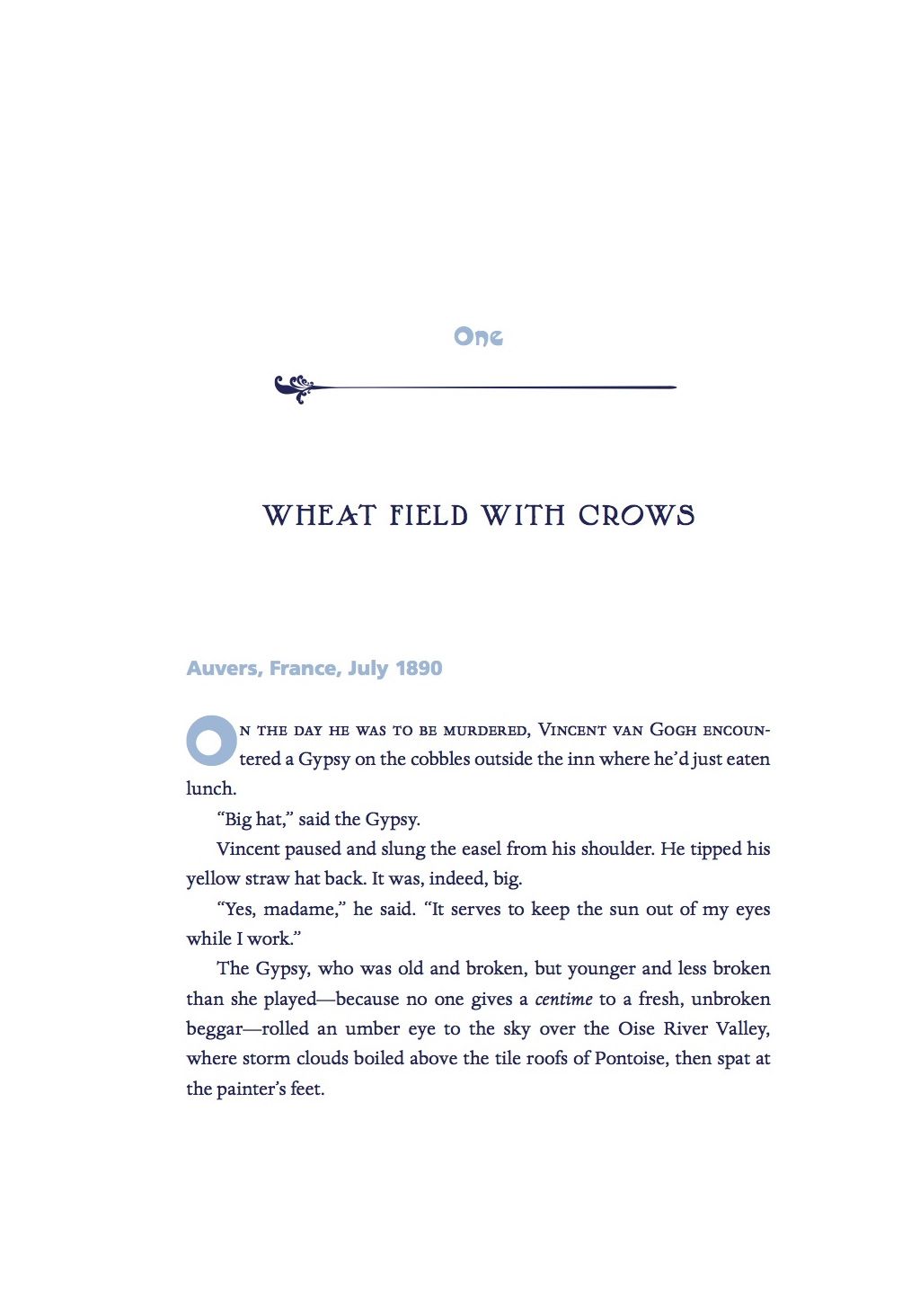
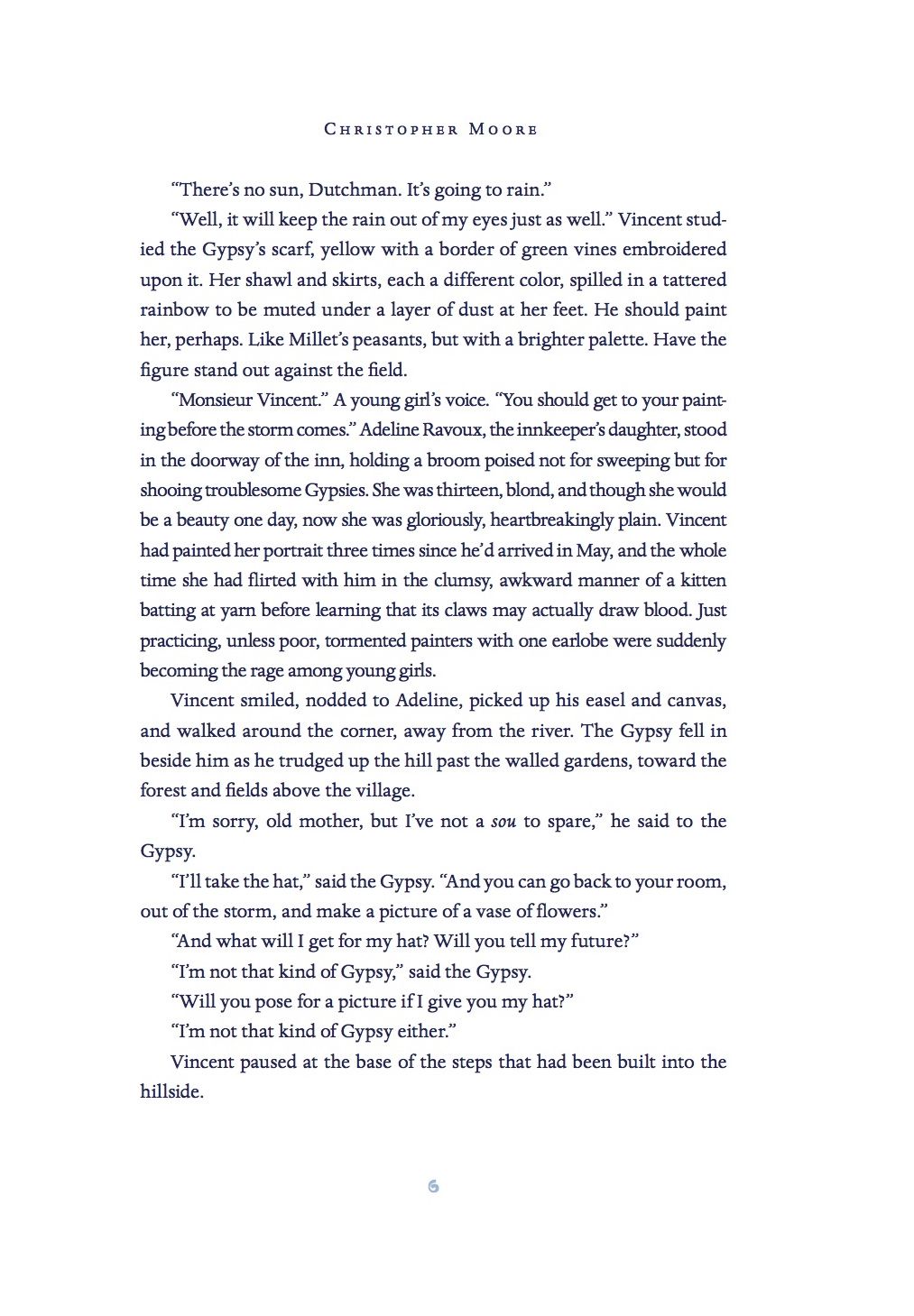
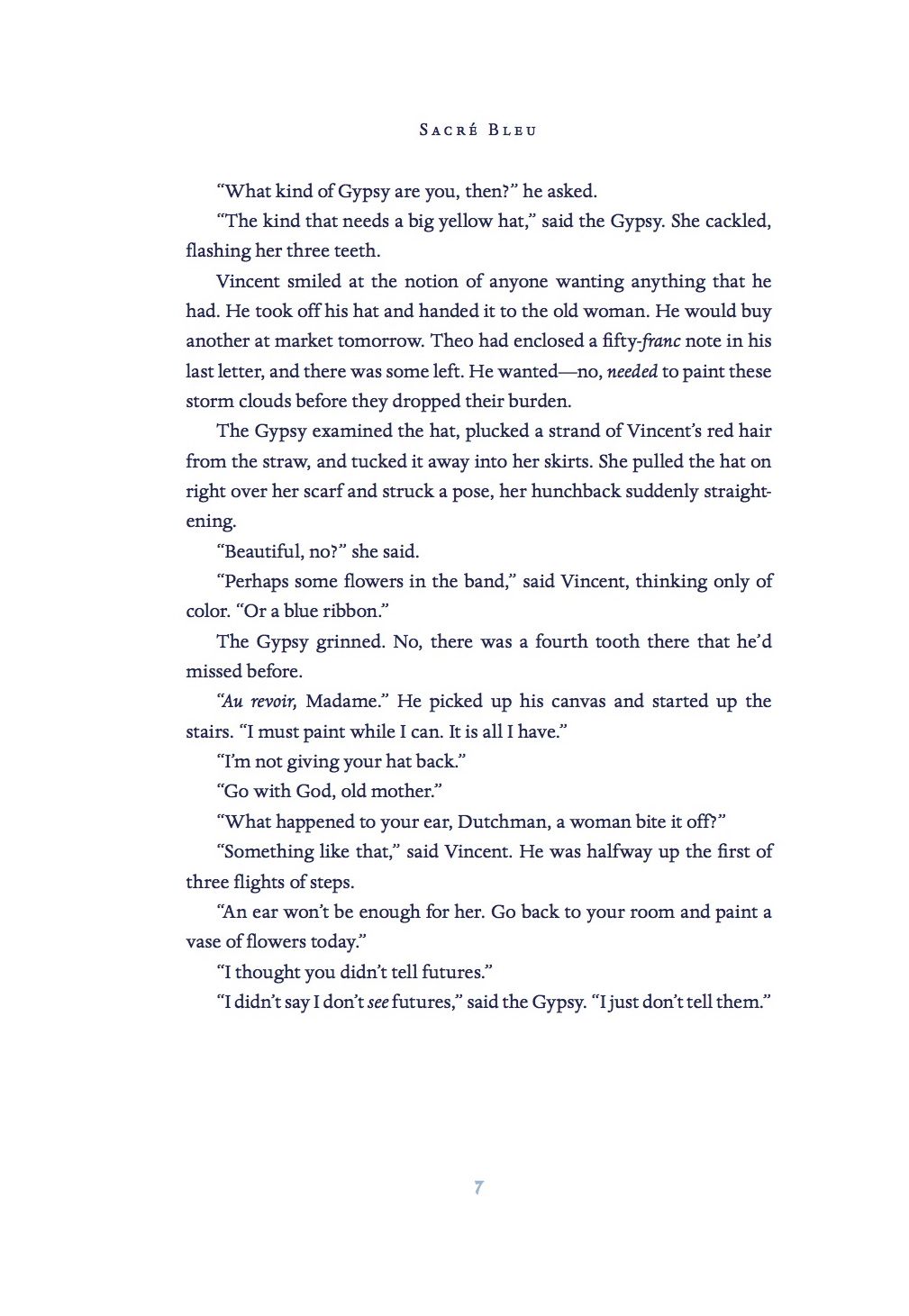
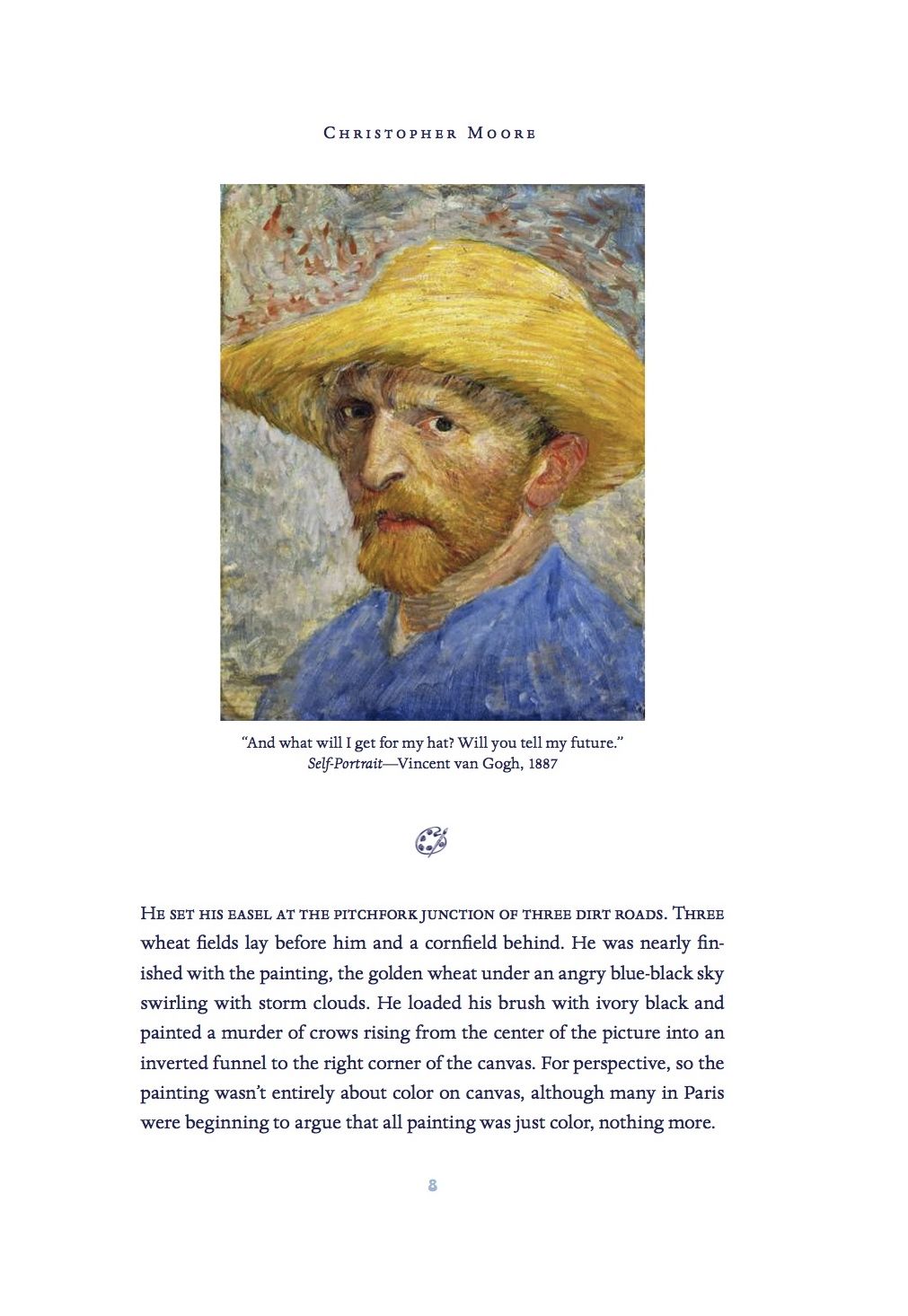
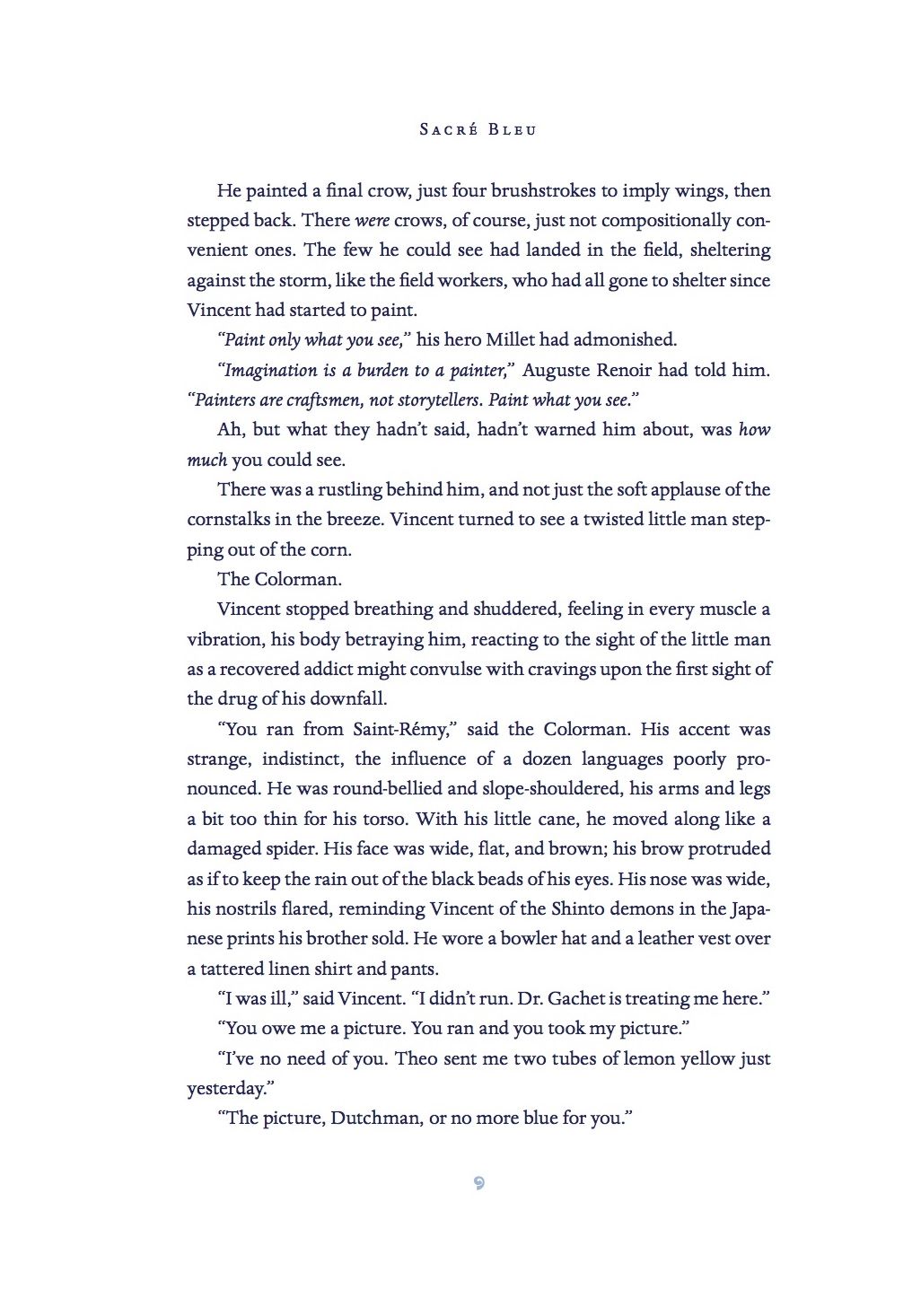
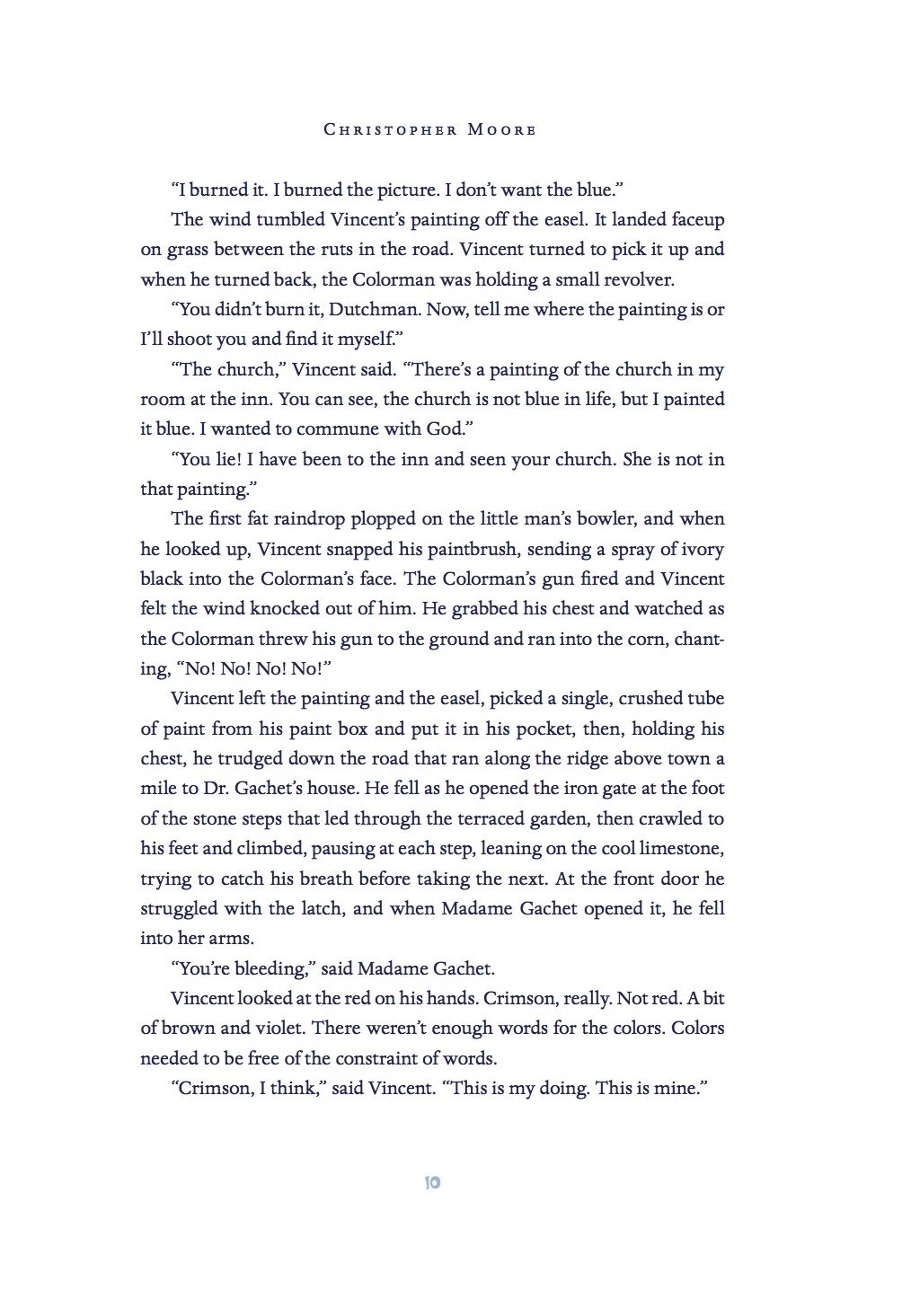
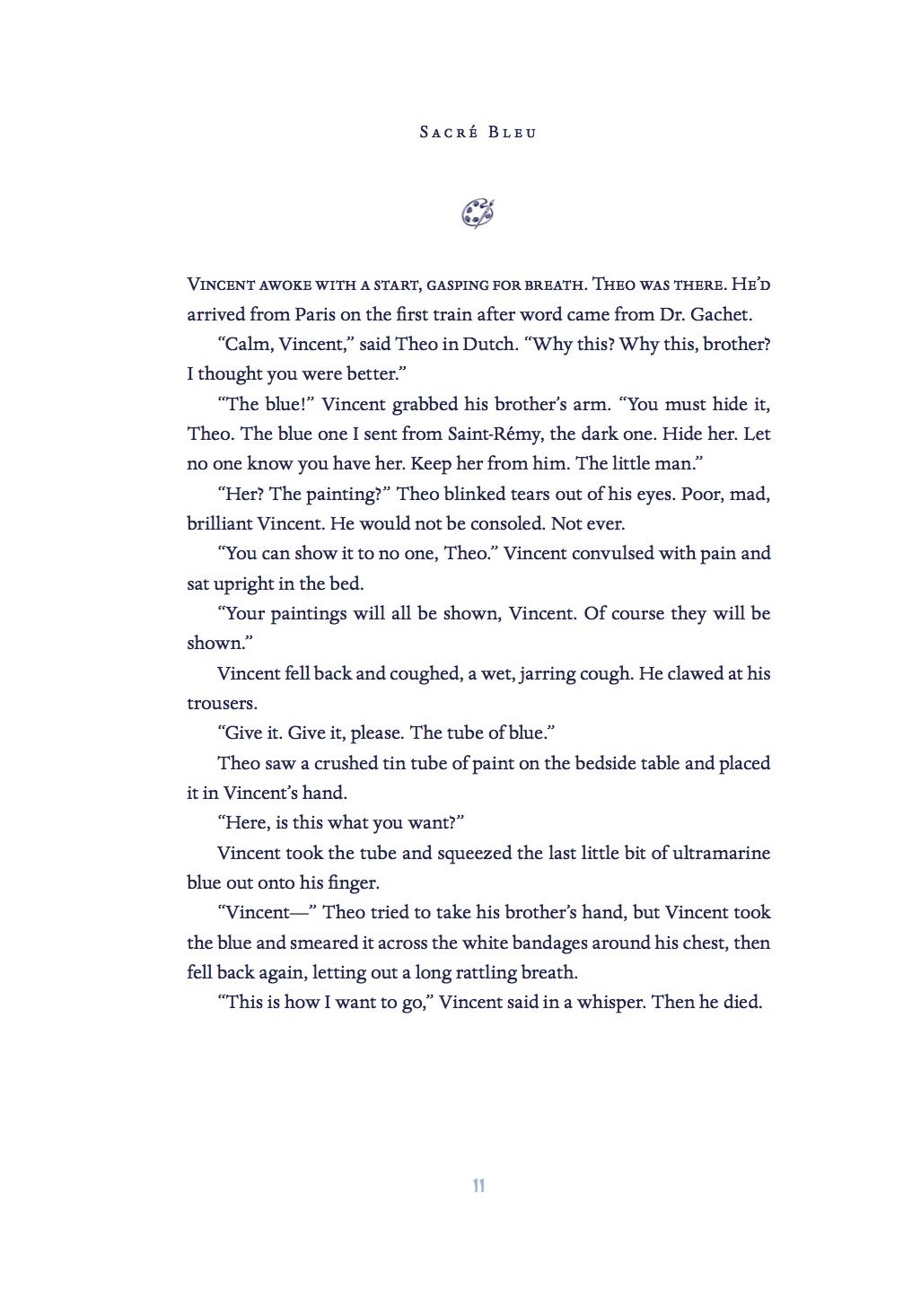
Sacré Bleu will be in stores April 3, 2012- Check my Facebook or Chrismoore.com for my tour schedule and any updates. Happy holidays. Thanks for helping me along on this great adventure.
Chapter 1 Guide
Welcome to the Chapter by Chapter Guide of Sacré Bleu. Here you’ll find some photographs, a little background on the geography, history, and art featured in the book, as well as observations and musing I had while researching and writing the book that just wouldn’t fit in the story, but I hope will give some perspective on it. I’ll add to this guide as time goes on, and not necessarily in order, so check back.
Chapter 1 Guide – Wheat Field with Crows
The Village of Auvers Sur Oise lay about ten minutes (by train) north of Paris, over the River Oise. Vincent lived here for several months after he left the sanitarium in Arles, after his famous breakdown in 1889.
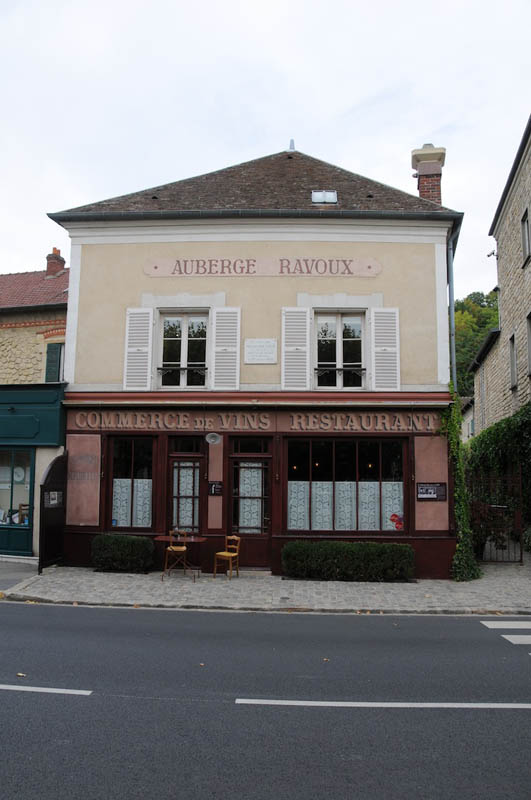
This is the Inn in Auvers where Vincent lived. This picture taken in 2009.
Chapter 2 – Guide
Chapter 2 – The Women They Come and Go
“he made his way across the square to the edge of the Montmartre, where he looked out over Paris, shining in the noon day sun”
View of Paris from Montmartre looking south-west over St. Denis. Today, of course, there are no more factories streaming smoke, but in Lucien’s day, there would have been dozens of smoke stacks, and you see that in a lot of Impressionist paintings.
Stairs today leading down the back side of Montmartre to Rue Caulincourt, where Henri and Lucien kept their studio.
“Lucien set off down the two-hundred and forty-two steps to that very same boulevard into the neighborhood around Place Pigalle”
The stairs from Montmartre to Place Pigalle today. Lucien would have been coming from even higher on the butte than this picture shows.
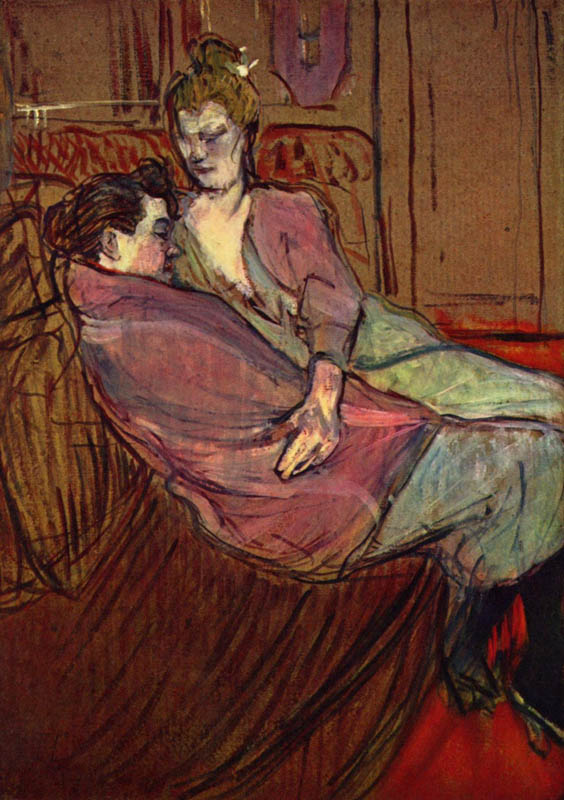 “In the salon of the brothel on Rue d’Aboise, a girl in a red negligee who had been dozing on a velvet divan when he came in…”
“In the salon of the brothel on Rue d’Aboise, a girl in a red negligee who had been dozing on a velvet divan when he came in…”
Two Friends – Henri Toulouse-Lautrec
Place Pigalle, which was alive with cafés, brothels, cabarets, and on some mornings, the “parade of models” around the fountain in the square.
Place Pigalle – Felix Buhot – 1878
You can see the fought on the right.
“I will vouch for that,” said Mireille, who scampered away, puffing
like a tiny marshmallow locomotive. “He loves that fucking hat.”
Drawing by Elias D’Elia
Eli drew this cartoon for me, but he came up with a much more 21st Century cute Mireille than the real one, as you’ll see below…
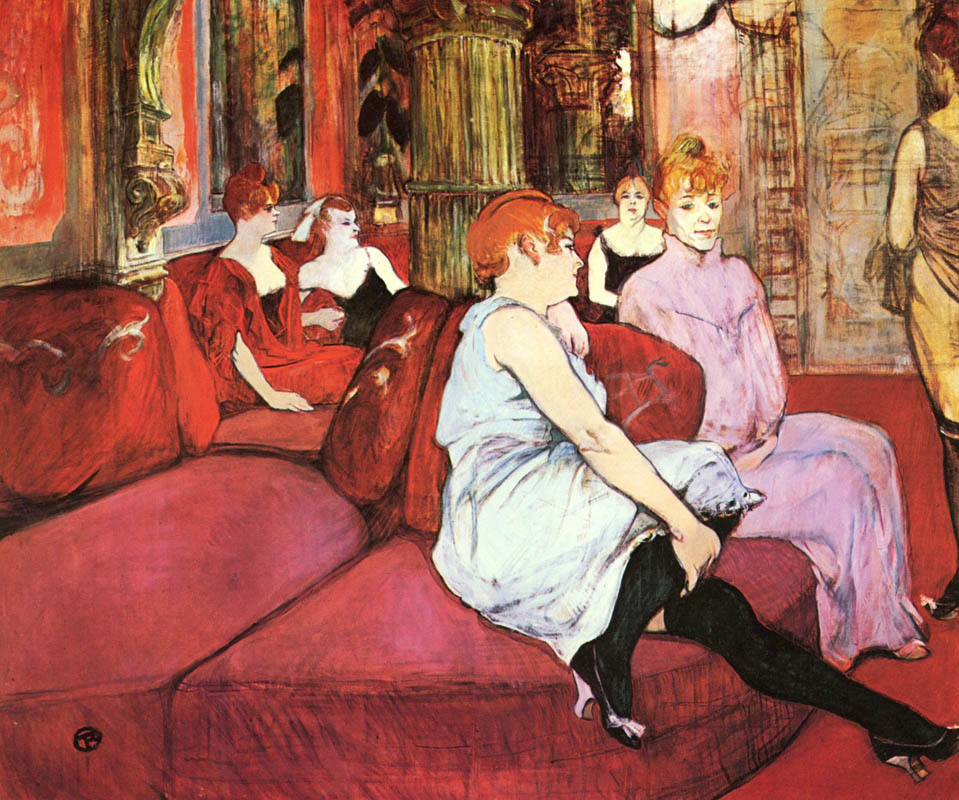 “Lucien was anxious waiting among the whores.“
“Lucien was anxious waiting among the whores.“
Parlor of a Brothel – Henri Toulouse-Lautrec
“I know you,” said the round blond. “You’re Monsieur Lessard, the baker.”
In Le Rat Mort – Henri Toulouse-Lautrec
This painting was actually of a patron of the restaurant Dead Rat, described in the scene where Henri and Lucien go to breakfast, but I found the image after I had already written the brothel scene and it was uncanny how close the woman was to the whore I described, so it went into the book. I realized later when I went through my photos, that I’d seen this painting in the Courtauld Gallery in London, so maybe it had stuck in my mind.
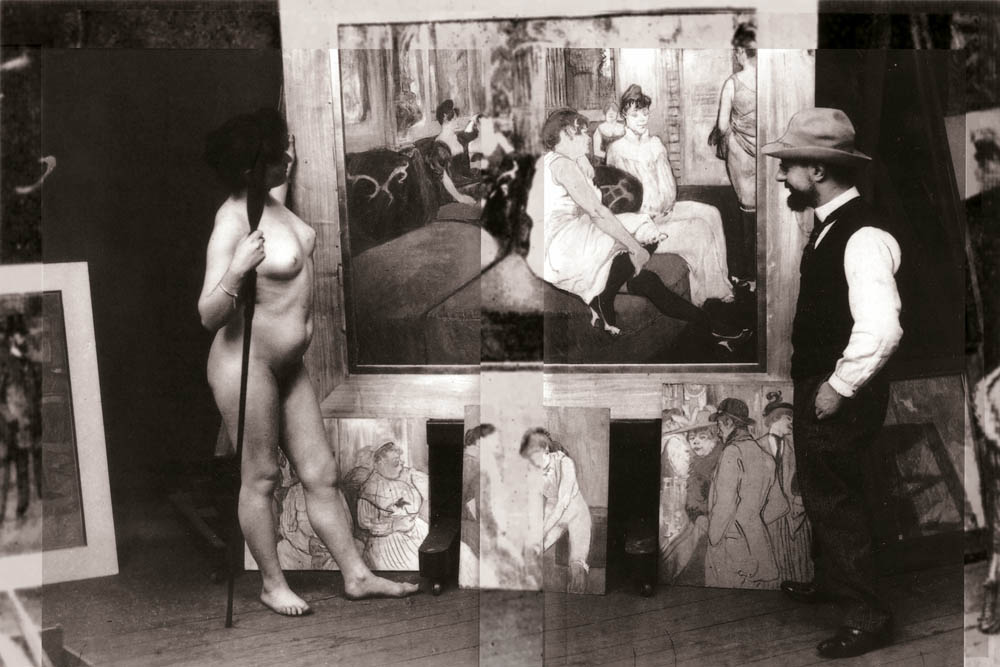 Mirielle and Henri Toulouse-Lautrec, with a collection of his brothel paintings. As you can see, Mireille, was, indeed, as tiny as Henri, and she was reputed to be his favorite.Photo by Henri’s friend, Maurice Guilbert, who we’ll see more from later.
Mirielle and Henri Toulouse-Lautrec, with a collection of his brothel paintings. As you can see, Mireille, was, indeed, as tiny as Henri, and she was reputed to be his favorite.Photo by Henri’s friend, Maurice Guilbert, who we’ll see more from later.
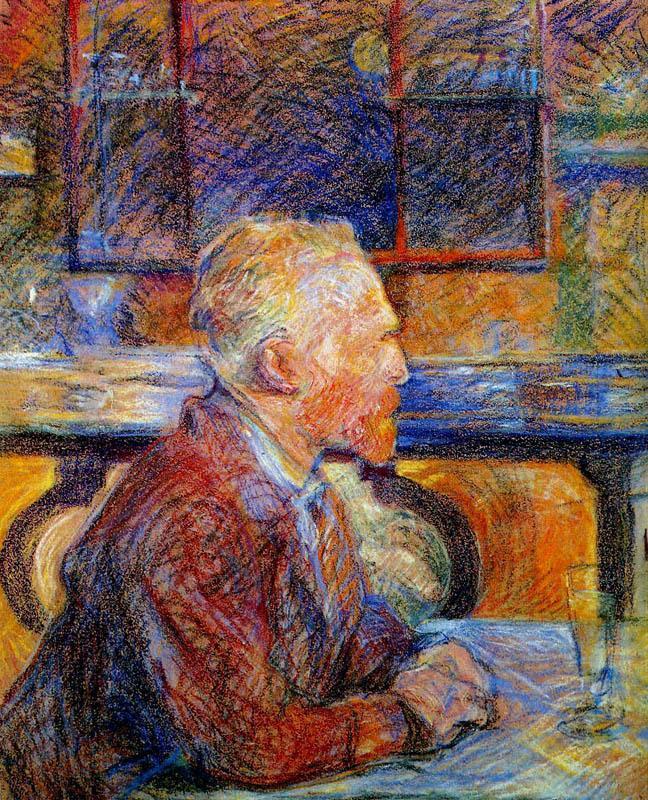 “They had both attended Corman’s studio with Vincent, painted along side of him, drank, laughed, and argued color theory with him in the cafes of Montmartre.”
“They had both attended Corman’s studio with Vincent, painted along side of him, drank, laughed, and argued color theory with him in the cafes of Montmartre.”
Vincent Van Gogh – by Henri Toulouse-Lautrec – 1886 or 87 when they were all studying at Corman’s Studio.
Vote for your Favorite Cover
Vote for your favorite cover for Sacré Bleu. You say: “But I don’t know what the book’s about yet?”
Exactly. Pretend you’ve walked into a book store, or a Costco, whatever, and you’ve never heard of the author, which of these covers would make you pick up the book to see what it’s about. Make a mental note of the title or number of your favorite and vote on Facebook here: http://www.facebook.com/questions/10150348340820067/?qa_ref=qd
We’ll call this
1. ART NOUVEAU
2: MOULIN ROUGE
3. ENCHANTED PALETTE
4: PINCE-NEZ & DERBY
5. VINCENT
An American in Paris – The trip to research Sacre Bleu
If you haven’t been there, it seems all too romanticized, all very cheesy, existential, bohemian — LaCroix dahling, LaCroix — so so fucking French. If you have been there, you have your own Paris, it’s yours, and believe it or not it is, will always be, better than mine.
I just learned this last night. Everyone has his or her own Paris. Parises are like snowflakes, or maybe more appropriately, like Rorschach tests. Each is unique, and you see only what YOU see.
“You have to go to this restaurant in the Fifth, called Frommage. Cheese! It’s called Cheese, that’s all they serve,” said a friend of my who is (and I’m not kidding) a cardiologist.
The “Fifth” refers to the Fifth Arrondissement, or district, which is how people talk about Paris. (Yes, I know you know that, from your semester abroad, or your honeymoon, or your back-packing trip around the Europe right out of college, but I didn’t know that until I’d marked nearly a half-century in small to medium-sized American towns, so other people may not, so shut up.) Like New Yorkers talk about Uptown, Midtown, Downtown, The Village, etc. In Paris it’s The Fifth, the Fourth, the Eighteenth, and some Arrondissement’s have very distinctive personalities and characters, they rise and fall in and out of fashion. But now you know what that means when someone says something like, “Oh, there’s this amazing Chocolatier in the Sixth.” Something that makes up their Paris.
“Look at all the figures over the doorway in Notre Dame,” says my friend Barry. “They’re supposed to be apostles, but they gathered all the Jews from the Marais to model.”
The Marais is the traditionally Jewish neighborhood of Paris, there will be more about that, but that’s where Barry, a New York born Jew living in Marin found his Paris.
“I proposed to my wife on the Pont Neuf,” said my publisher when I told him I was going to write a book set in Paris. “And then we were robbed at gunpoint and escaped by jumping across the path of a moving car.”
The Pont Neuf is the oldest bridge in Paris, dating back to the 16th century, and covered with stone masks of old gods and heroes that have had to be replaced many times over the years as they were eroded away by the acid rain. It’s also where my publisher found his Paris, clearly in a scene out of a Cary Grant, Audrey Hepburn movie. (There will be photos, but I haven’t left yet.)
“Pont”, is the French word for bridge, by the way, so you haven’t wasted your time. You’ll always know that now.
“I love to just sit in the Place du Royal in the Marais,” says my friend Valerie. “Just sit there, reading a book, with the sun on my face, watching the people go by.”
“There’s a little restaurant, about half-way up Mont Martre,” says my agent. “Called La Maison Rouge, just the kind of place you want to stop and have a sandwich and a coffee and take stock of your day.”
Everyone has his Paris, I’m fixin’ to go find mine, and I’m going to share it, as much as I can, here, with you.
Oh, I’m going to get shit wrong, seriously wrong. I’m going to misspell the shit out of French words, and I’m going to tell you stuff that your art history teacher back in 1983 told you completely differently. That’s okay. I’m always the last one to know, and I’m sort of used to you guys always knowing how to spell and whatnot. And your shit is right in your Paris, but this is my Paris, we’re talking about. Paris is like The Forbidden Planet that way – where the aliens reached into your mind, then constructed your own fantasy for you out of your consciousness. ( And I’m not going to have time to stay up all night Wikipeding and spell checking – and French just about makes the spellchecker ‘splode with frustration. So there will be wrong shit. That’s why God gave you Google, because I cannot be trusted.) My Paris!
Oh, I’ve been there before, just a couple of years ago, when I was researching Fool, and I was really just stopping over on my way to look at some Medieval cities in other parts of France, but if I had to say now, my Paris, beyond the Polar Bear sculpture at the Musee D’Orsay, or the hot dogs served in a hollowed-out baguette, with melted brie and Dijon mustard off a cart on the Champs de Elysees. (Which you pronounce, more or less, shaaamps d’leesay, and means, Elysian Fields, or “Field where our heroes are buried”. It’s one of the wide boulevards in Paris, a highly fashionable one, at the end of which is that big-ass arch you always see in pictures, The Arc de Triomphe, which Napoleon built because he felt that Paris should have a Big Ass Arch. ), my Paris is summed up in the picture below, which was taken by Charlee, the mysterious woman who has lived with me for the last 15 years and whom I have met several times.
This was taken at about 8:00 in the morning, on a Tuesday, on MontMartre, which is the almost rural butte right in the middle of Paris (where the Impressionists lived and painted, as well as Van Gogh, Lautrec, Gauguin, the composer Eric Satee, where the Chat Noir nightclub, that you seen the poster for a million times, was located, and were Amelie was filmed — for the most part.)
I call it “Morning Love.” These two have obviously had a long night looking for their own Paris. Dancing may have been involved.
I leave in a couple of days. I’ll report in soon from Paris. Come on, it will be fun.
Je suis ecossais An American In Paris 2
So I knew some time ago that I was going to go to France to research my next book, and my entire French vocabulary consisted of: “Two coffees and two croissants”, “please”, “thank you”, “hello”, and “the dog is on the table” I didn’t figure that it was enough to get me through a long research trip.
Scientists all agree that there is no better time to learn a foreign language than in your 50s, when you begin to forget words in your native language as well as other useless stuff, like the PIN to your checking account, the names of your children, and where your car keys are, which leaves room in your brain for new words and phrases.
The first thing I did was buy some software we’ll call Mosetta Stone, where you are given many French words, and you click the picture corresponding to the word or phrase. You’ll immediately learn to say things like, “The Boy is on the airplane. The boy is under the airplane. The airplane is on the boy,” and so on. By the third lesson you are able to understand complex things like, “The two boys are under the blue airplane.”
Within a week I could identify any number of boys in nearly any attitude to any colored airplane, and I could do it with 100% accuracy, which would be about useful in Paris as my ability to shred Baba O’Reily in Guitar Hero would be if I were thrown on stage at Royal Albert Hall with the Who and a Stratocaster. (In fact, my ability to mow down enemies with a warthog in Halo will probably serve me better in the roundabout at the Arc de Triumph than all of Mosetta Stone’s airplane boys will at anything.)
So, on the lookout for a kid under an airplane, I enrolled in a course at Alliance.
I know you think that I enrolled at a placed called A-LIE-ANCE. But that’s because you don’t know French, where absolutely nothing is pronounced how it’s spelled. (It’s Al-eee—anz” you American pig dog.) I know, I shouldn’t really criticize, when English has words like “know” and “enough”, which appear to have been put in the language just to fuck with foreigners. In fact, during WW2, instead of having an Enigma code machine, for security, our spys were instructed just to use Enough and Phaeton in a lot of sentences. What you absolutely need to know about French is that with the exception of that hairball sound you find in words like Jaques, all consonants are silent. This is one of the reasons that the French make such great mimes. In fact, when I got to Alliance, I totally expected to be handed a striped shirt and a beret and to be walking white-faced in the fucking wind from the jump, or le saut , as they say in France. But non. Non, non, non.
First, Alliance is in the Tenderloin, which means that if I wanted to pick up modest rock of crack and or get stabbed on the way to class, I was totally in the right neighborhood, and, in fact, when I walked into class a few minutes late that first day, my excuse was that I had to wait for the guy lying in the doorway in a pool of his own sauce to be bagged and rolled off to his own Champs-Élysées before I could get in. But I didn’t know how to say that in French, and Alliance uses an emersion teaching method, which means you’re only allowed to speak French. So there were eight of us who didn’t know a fucking word of French, and one teacher, who knew a bunch of French and English, but she wasn’t allowed to tell us what she was saying.
So, after I explained that I was late because of the dog on the table, we all sat there for an hour, listening to our teacher spout French nonsense, while the realization rose like a specter in our Anglo-speaking minds, that we were being taught by France’s only mime-challenged teacher. So that went on for nine weeks – up early every Tuesday morning, picking out a shirt that wasn’t red or blue so it didn’t attract any gang attention, then hop-scotching through the unconscious and life-challenged “Loiners” to watch a pleasant French woman talk incomprehensible vowels at us for an hour while we traded glances which said, in the international language of raised eyebrows and furtive nods:
“Know what she’s talking about?”
“No fucking idea.”
So, I turned, as is often the case with those lacking communication skills, to the internet.
And after a couple of false starts with some immersion-based podcasts (really, the Ipod equivalent of being water-boarded), and a couple “French word a day” programs, (and by this time, three months from leaving, a word a day was going to give me just a little better vocabulary than a cocker-spaniel by the time I got to Paris (and unlike a cocker-spaniel, I was well past my cute, tail-wagging-charm sell-by date) I stumbled across the Radio Lingua Network, and Coffee Break French.
French taught by Scottish people! Can I get an Amen? Can I get a hallelujah?
As many of you know, it was my experience while in Edinburgh a couple of years ago, that it is easier to understand a French person speaking French, when you don’t know French, than it is to understand a Scottish person speaking English, and somewhat less humiliating, because French people are not, ostensibly, speaking your language. (While in Edinburgh I ate almost exclusively at Pizza Hut because A)I could order by number, and B)I didn’t figure they could sneak a haggis on a pizza without my knowing. I tried a Chinese restaurant once, going on the number theory, but I’m pretty sure those sneaky fuckers slipped me some Moo Shoo Haggis under false pretenses.)
Anyway, Coffee Break French was awesome. Fifteen to twenty minute lessons, which was about the length of time it took me to walk to the gym or the grocery store, where you build phrases up as you go along, and the instructors actually tell you what in the hell they are saying. You don’t get immersed in French, just a little damp, and dampness is something the Scots rock at.
The course is taught by Mark and Anna. Mark seems to be one of the very patient teachers who knows way too much about his subject, but still has some sense of what it is to be a complete neophyte, and Anna is learning along with you, so you don’t feel like a total knob, and while you get the sense that she’s dumbing down a little for you, I’m used to being treated that way, and her accent is cute as hell, so it’s okay. If Disney had a Scottish princess maybe, or there had a been a sweet, single-malt whisky dancing with the teapot in Beauty and the Beast, Anna could play that part. Don’t get me wrong, she’s Scottish, and you know that at the drop of a hat she’d be half-painted blue, shirt pulled up, waving her semi-azure bosoms and a sword at Edward Longshanks, and harshing out “you kinna take our freedom” in deeply mucousy Gallic, but still, very pleasant, is what I’m saying.
A few lessons in, they have some video specials, and then you see that Anna is, indeed, a cute young college student, and Mark is one of those sturdy, bullet-shaped fellows you find on the internet, patiently explaining stuff to you that no one else seems to be able to completely grasp. (LikePatrick Norton) Forty years ago his kind would have been milling the heads on your Sunbeam Tiger so you could pull 300 horsepower for Sunday’s rally, and a hundred years ago he would have been urging you not to lick the contacts on the dry cell battery that ran your doorbell because it corrodes the contacts and it is, incidentally, poisonous.
Both of them, of course, are complete strangers to the sun, as is any good Scot. They have enough color from wind burn, so as not to appear eye-less albino cave people, but just. This is perfectly normal and let’s you know that they are legitimate Scots, even if you can actually understand them when they’re speaking English and they seem strangely comfortable speaking fucking French. (Once I was in Edinburgh on a brisk fall day of about forty-five degrees (F), and when the sun came out from behind a cloud, people started shedding their clothes like they were on their way to the annual autumn shaggathon at the Sir Walter Scott’s grave. (Sorry if that’s a real holiday, Scotland. I dinna know.) The park near the art museum looked as if there were fleshy inflatable sheep-people floating across it as the sun-blissed Scots frolicked and steamed through the frost. You know that one insane guy at the Denver Broncos or Buffalo Bills game with his shirt off in mid-December, painted blue, spilling a beer all over himself even as everyone else is dressed for arctic conditions? Put that guy in kilt, give him a red-haired wife, and two kids eating ice-cream, that’s what I’m talking about. Then the sun went back behind the cloud and everyone was back in black. They have a lot of Goth boutiques in Edinburgh, they call them boutiques. But alas, I digress. )
So anyway, one of the first things I learned from Mark and Anna, is how to say, “I am Scottish.” It sounds kind of cool: Je suis ecossaise. I’m going to go with that. I’m about fifty lessons in, and I’m starting to learn a little grammar and verb conjugation and so forth, and while I realize that seems, at first, like a good reason to develop a drinking problem or a suicide pact, the amazing thing is that I’m far enough along in the language that grammar’s actually useful. I mean, I have no idea if I won’t just be the victim of a fun French game of “Let’s Murder the Scotsman”, but I’m feeling much more confident than I was when all French class was getting me was a chance at meeting a one-legged hooker or being gunned down in a drive-by and gasping out my last words about the boy under the yellow airplane with no audible consonants. (Back then I had started wearing plaid to my lessons so it couldn’t possibly be interpreted as gang colors. Ironic, non?)
If you want to learn some French, or a dozen or so other languages, give Radio Lingua a try. The podcasts are free and are available on Itunes, but they also have enhanced podcasts and lots of printed material if you subscribe, which I would have, except they only took Paypal when I checked them out and I would have to stop ignoring all my Paypal spam if I use that account. (They may have started taking credit cards more recently.) Hang in for some of the later lessons, in the late 30s, I think, where they actually go to a French beach and you can hear Mark and Anna softly sizzling in the sun while they speak French to natives. It’s fun.
I’m off to Paris. Adieu.


